Finishing your basement transforms an underused area of your home into a vibrant living space, enhancing both its functionality and market value. Whether you're looking to add a cozy family room, an efficient home office, or a playful recreation area, the possibilities are endless.
In this blog, we'll guide you through what to expect during the basement finishing process. From initial planning and addressing structural necessities to the final touches that personalize the space, we cover the essential steps.
Before you dive into the transformation, set a solid foundation for your basement project's success with meticulous planning and preparation. This preparation phase streamlines the process and helps avoid costly mistakes and delays.
Effective planning involves envisioning how you want to utilize the space, whether for additional living quarters, a home gym, or a playroom for the kids. This initial step sets the direction for all subsequent decisions.
Establish a clear budget early on. Consider all potential costs, including materials, labor, and any unforeseen expenses. This will guide your choices and help you manage your resources efficiently.
Align your design preferences with the intended function of the basement. Whether you favor a modern look or rustic charm, your design elements should reflect the purpose of the space while ensuring cohesiveness with the rest of your home.
Clearly define how you plan to use the space. Each potential use might require different considerations in terms of layout, materials, and features. For instance, a home theater requires different acoustics and lighting compared to a workout room.
Familiarize yourself with local building codes to ensure your basement renovation meets all legal standards. This can include requirements for ceiling heights, egress windows, and electrical systems.
Obtain the necessary permits before commencing work. This step is crucial for ensuring safety and compliance with local regulations. Permits are often required for structural, electrical, and plumbing changes.
When finishing your basement, the design choices you make define the space's function and feel. Here’s how to approach the design process to ensure your basement is functional but also inviting and cohesive with the rest of your home.
Consider the intended use of your basement. Each function — be it a family room, gym, or office — requires specific design elements:
Basements often lack natural light, making them feel cramped and gloomy. To counter this, opt for light colors for walls and ceilings to reflect any available light. Consider enlarging small windows or adding new ones if the structure allows, which not only brings in more light but also improves air quality and connection to the outdoors.
Select colors and materials that brighten the space and create an inviting atmosphere. Light hues, such as soft grays and warm whites, make the area feel larger and more open. Use materials that are functional and match the design of the upper floors to maintain a consistent style throughout the home.
To make the basement feel like an integral part of your home, extend design elements from the main levels into the basement. This might include similar molding, matching flooring, or complementary wall colors.
Ensure the transition from the main part of the house to the basement is smooth and natural.
When renovating your basement, conduct thorough structural and safety inspections to ensure the space is both functional and safe for long-term use.
Before starting any cosmetic updates, check your basement for signs of moisture or water damage. Look for damp spots, water stains, or mold growth. Solutions might include installing a sump pump, improving drainage, or applying waterproof sealants to walls and floors. Addressing these issues early prevents costly repairs and ensures the longevity of your renovation.
Proper insulation is vital for maintaining a comfortable temperature year-round and for enhancing energy efficiency. Insulate walls, floors, and ceilings to prevent heat loss and manage heating costs. Ventilation is equally important for controlling moisture levels and improving air quality. Adding vents or a dehumidifier can maintain a healthy living environment.
Safety should always be a priority in any basement renovation. Install egress windows to provide natural light and a safe exit route in emergencies. Ensure that all egress windows meet local building codes in terms of size and accessibility.
Also, smoke detectors and carbon monoxide detectors should be installed to enhance fire safety, and staircases should have sturdy handrails. Use flame-retardant materials where possible.
When transforming your basement into a functional living space, carefully planning the electrical and plumbing systems is crucial. These systems support daily activities, ensure safety, and comply with local codes.
Ensure your basement has ample electrical outlets and appropriate lighting for its intended use. Strategically place outlets around the perimeter and consider specific needs for entertainment systems and workstations. Plan diverse lighting layouts to enhance both ambiance and utility, incorporating overhead, task, and accent lighting.
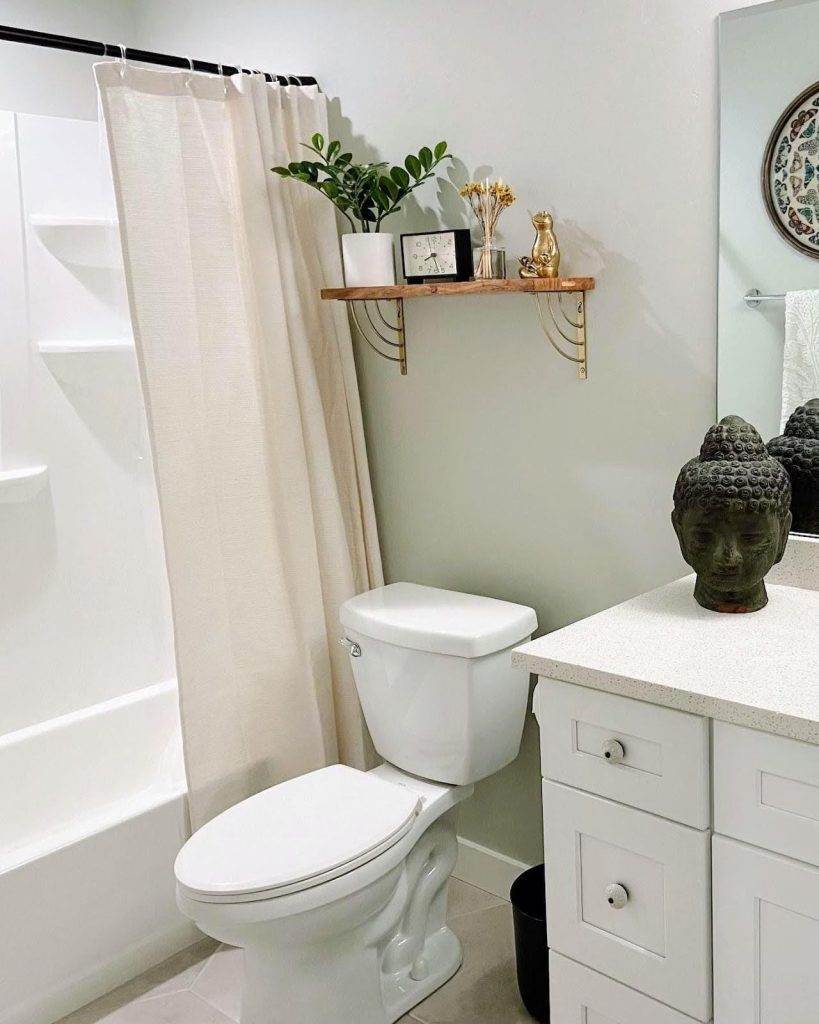
Meticulous plumbing planning is essential when adding bathrooms or kitchens. Choose fixture locations thoughtfully, considering their connection to the existing plumbing system. Verify local building codes and secure necessary permits to ensure compliance.
Electrical and plumbing work requires specialized knowledge. Hiring licensed professionals ensures correct, safe work that adheres to building codes and passes inspections. This approach protects your investment and prevents potential issues from improper installations.
Finalize your basement by selecting finishes and fixtures that boost functionality and mirror your personal style, transforming it into a cohesive part of your home.
Opt for durable flooring like vinyl, laminate, or engineered wood that is suitable for moist environments. Choose wall finishes that resist humidity and enhance aesthetics, such as mold-resistant paint or decorative paneling. For ceilings, consider drop ceilings for easy utility access or paint them for a seamless look.
Tailor fixtures and furniture to the basement’s function. In a family room, invest in comfortable sofas and sufficient lighting. In a home gym, choose compact, multifunctional equipment. Arrange furniture to support easy movement and space utility.
Personalize the space with items that reflect your interests and personality, such as artwork, decorative throws, or collections. These personal touches integrate the basement with your home’s overall style and enhance comfort for all users.
Consider several key adjustments to effectively address common issues in basement renovation. Enhance the sense of space under low ceilings by installing recessed lighting and applying light-colored paints. Incorporate visible support beams into your design either as distinct architectural features or by disguising them with built-ins and decorative elements.
For uneven floors, apply self-leveling concrete to make minor adjustments or install floating floors, which are designed to accommodate such irregularities. These strategies help to maximize the functionality and aesthetic appeal of your basement space.
Implement innovative and practical solutions to creatively overcome structural challenges in your basement. To maximize height, draw the eye upward with vertical lines and features, and select low-profile furniture to enhance the perceived ceiling height. Paint beams and ductwork to match the ceiling and integrate them into the room's aesthetic.
Choose moisture-resistant flooring materials that install easily over imperfect surfaces, ensuring durability and ease of maintenance. These strategies improve the functionality of your basement and its overall appeal.
Develop a comprehensive plan that includes a timeline and budget before initiating the basement project, breaking it into phases, and prioritizing tasks. Allocate a contingency fund of at least 10-20% of your total budget to manage unexpected expenses without derailing your project.
Conduct regular progress check-ins to adjust the timeline and budget as necessary. Maintaining effective communication with your contractor helps mitigate delays and ensure you stay informed about the project's status, ensuring a smooth completion
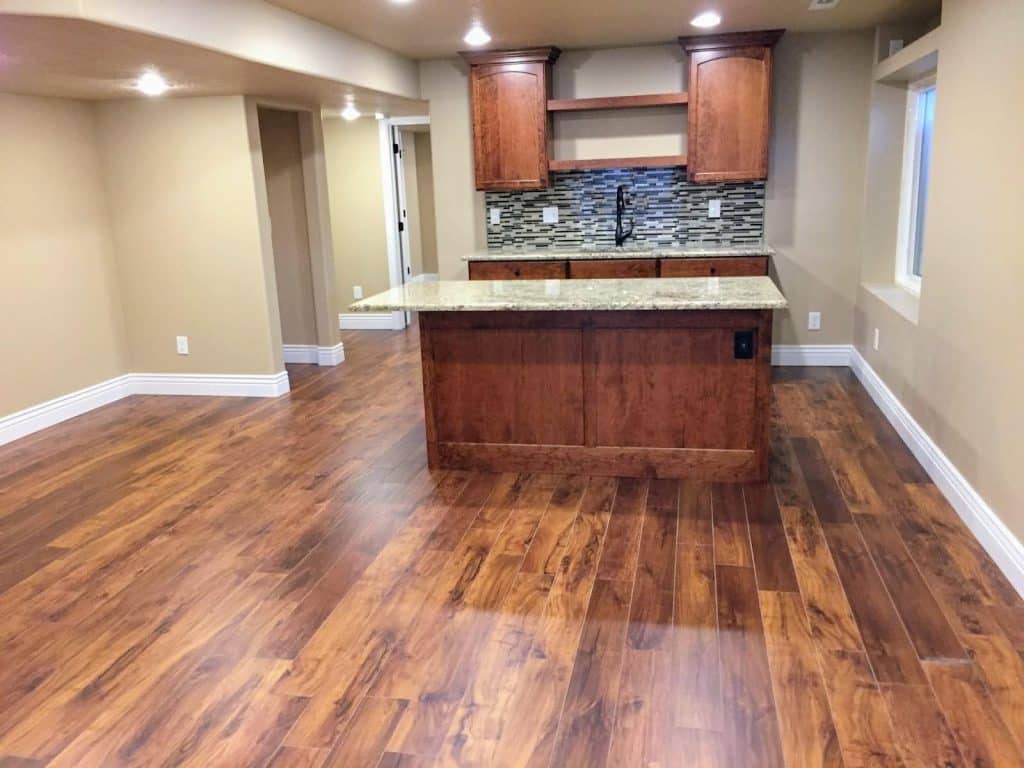
CCS of Utah is ready to bring your basement vision to life. Our expertise in custom renovations provides tailored solutions that blend creativity, practicality, and meticulous attention to detail. Whether you're adding a family room, a home office, or an entertainment hub, our team handles every aspect of your renovation project.
We pride ourselves on quality craftsmanship and personalized service, working closely with you to ensure your basement project meets your expectations and enhances your home’s value and functionality. Trust CCS of Utah to transform your basement into a space where memories are made and cherished.
Ready to start your transformation? Contact CCS of Utah today to begin crafting a beautifully finished basement that perfectly fits your lifestyle and meets your family’s needs.
Transform your basement into a multi-functional living room to maximize your home’s space and adapt to your family’s diverse needs. A versatile basement serves multiple functions — from entertainment and relaxation to work and study — providing a dedicated area for each activity.
This blog will explore how to effectively utilize your basement for entertainment, relaxation, and work, ensuring it becomes a dynamic, comfortable, and productive space for the whole family.
Before transforming your basement, comprehensively evaluate its current layout to understand its potential and limitations. Analyze how the space flows and is segmented to determine areas that can best support your functional needs.
Measure the dimensions — length, width, and height — and note the positions of doors, windows, and staircases to facilitate effective space planning and furniture arrangement.
Identify any structural barriers, such as load-bearing walls or fixed utilities, that could affect your redesign plans. Consider consulting a structural engineer to address these issues proactively, ensuring safety and preventing future complications.
Basements often suffer from poor light and airflow; assess the natural light available and consider enhancing it by enlarging windows. Also, ensure adequate ventilation to improve air quality and prevent moisture buildup, making the space more comfortable and inviting.
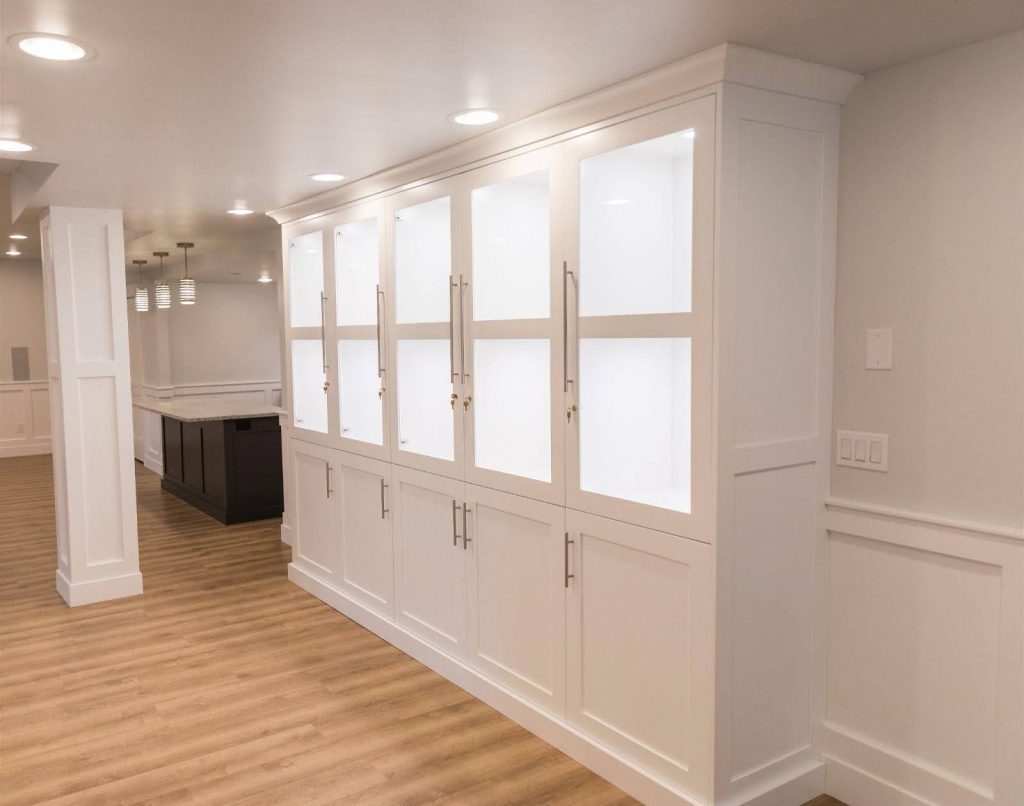
Maximize your basement's functionality by strategically dividing it into zones tailored to your family's favorite activities — movie watching, playing, working, and exercising. Arrange these zones to balance active and quiet spaces, enhancing the basement's overall utility and flow.
Use bookshelves, couches, and console tables as subtle dividers to define different areas without compromising the openness of the space. For increased privacy or sound control, consider curtains, sliding panels, or partial walls, which are perfect for isolating workspaces or creating quiet study nooks while also adding a decorative touch.
Differentiate these areas visually with varied paint colors, wall art, or flooring choices. This allows you to theme each zone according to its use while maintaining a unified look throughout the basement.
To create a versatile basement living room, prioritize adaptable furniture and movable partitions to meet your family's changing needs. Choose multi-purpose pieces like guest sleeper sofas and extendable tables to accommodate different group sizes.
Incorporate storage ottomans for seating, footrests, or tables to maximize utility without taking up extra space.
Invest in fold-down desks and Murphy beds to easily transition the space from everyday living to specific functions, such as a temporary office or extra sleeping area. Utilize sliding panels or rolling dividers to swiftly alter the layout, allowing you to tailor the space for various activities, whether creating quiet zones or open social areas.
Opt for modular storage systems that you can reconfigure or relocate to adapt to evolving storage needs and help delineate different areas. These adaptable solutions ensure your basement remains functional and responsive, effectively accommodating your family's lifestyle changes.
Transform your basement into the ultimate entertainment hub by setting up a dedicated home theater or gaming zone enhanced with thorough soundproofing. Select an area with optimal visibility and acoustics, and install a high-quality projector or screen alongside a surround sound system.
Arrange tiered seating, such as recliners or sectional sofas, for maximum comfort and viewing enjoyment.
Equip the space with multiple monitors or a large TV, ergonomic gaming chairs, and media storage for organizing consoles and accessories. Adjust the ambiance with LED lighting suitable for various games.
Install acoustic panels, sound-absorbing foam, and specialized insulation to contain noise. To further minimize sound transmission, enhance this with acoustic tiles in a dropped ceiling and thick carpets or soundproof underlays on the floors.
Ensure the area has ample power outlets and strong Wi-Fi connectivity. Use cable management systems to maintain a tidy and safe environment.
These enhancements will transform your basement into a high-end entertainment zone perfect for immersive movie nights and gaming sessions without disrupting your household's peace.
Transform a section of your basement into a peaceful retreat, perfect for relaxation and quiet time. Choose a corner away from high-traffic areas, preferably near a natural light source. Use soft LED lighting or lamps to create a warm, welcoming atmosphere if light is scarce.
Place comfortable, plush furniture like an armchair, chaise lounge, or small sofa at the heart of your nook. Enhance the coziness with soft throw blankets, pillows, and area rugs in soothing textures.
Install dimmable warm lights, such as table lamps, floor lamps, or string lights, to adjust the ambiance to suit your mood or time of day.
Personalize the space with serene wall art, family photos in calm tones, and shelves filled with favorite books or personal treasures. Add indoor plants or a tabletop fountain to bring elements of nature indoors.
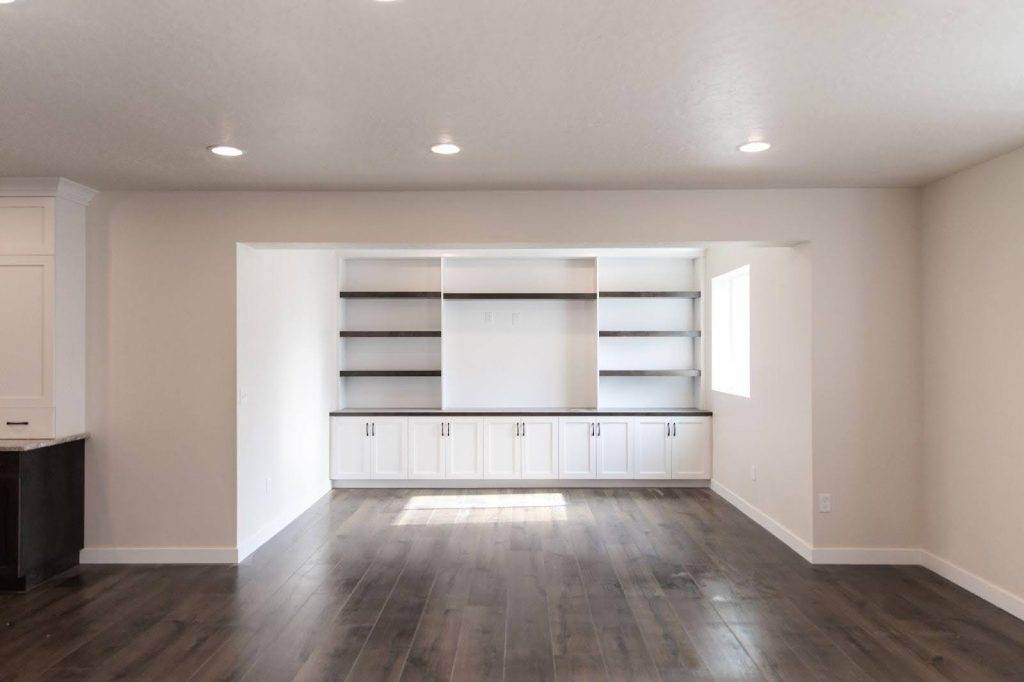
Maximize storage in your multi-functional basement without compromising style or usability through strategic solutions. Install custom shelving or cabinetry in underutilized areas like under staircases or along walls. Ensure these units match your basement's decor for a seamless integration, maximizing every inch of space.
Opt for multi-functional furniture that doubles as storage — such as beds with drawers or coffee tables with additional shelving — to keep essentials accessible yet out of sight. Use hideaway storage options like wall-mounted fold-up units or storage benches that also serve as seating to maintain a clutter-free area.
Leverage vertical space by adding tall shelving units or hanging systems, ideal for keeping items off the floor and out of the way, particularly in craft or utility spaces. These storage solutions keep your basement functional, tidy, and well-organized, enhancing both the utility and enjoyment of the space.
Effectively use lighting and color to boost both functionality and ambiance in your multi-functional basement. Customize lighting for each zone; employ bright, focused lights for workspaces, soft, dimmable options for relaxation areas, and adaptable ambient lighting for entertainment spaces that can change color and intensity.
Add task lighting where you need precision, such as desk lamps in study areas or pendant lights over game tables, to enhance functionality and comfort. Use neutral tones as a base across the basement, and incorporate bold colors to highlight active areas. Choose calming blues and greens for tranquil zones and warm, vibrant colors for social spaces.
Create smooth transitions between areas with subtle shifts in lighting and color to maintain cohesion while clearly defining each zone. Incorporate mirrors or reflective elements to amplify light in darker or smaller areas, increasing overall brightness and the sense of space.
Transform your basement into a functional and inviting space with CCS of Utah. Our team excels in custom renovations, blending creativity, precision, and practicality to deliver high-quality results. We prioritize craftsmanship and personalized service to enhance both the comfort and value of your home.
Trust CCS of Utah to manage your renovation with care and professionalism. Contact CCS of Utah today to start creating a basement living room your family will cherish.
Renovating basement stairs enhances your home's aesthetics, safety, and functionality. Stairs are essential for managing daily traffic, especially in high-use areas like basements, and require careful consideration of materials, building codes, costs, and design compatibility.
This blog demystifies the renovation process, covering everything from initial assessment and design options to the construction details. By understanding each step, you will make informed decisions that ensure your renovated stairs are safe and stylish, perfectly complementing your home.
Before tackling a renovation, it's crucial to thoroughly assess the current condition of your basement stairs. This initial evaluation will help determine the extent of the renovation needed and ensure that the new stairs will be safe and compliant with local building codes.
The first step in this process is checking structural integrity. Examine the stairs for any signs of damage, such as cracks, creaks, or wobbly parts. Pay special attention to the stringers — the structural supports running along both sides of the stairs. Issues like this compromise the entire staircase, making it unsafe.
Assessing material wear is also essential. Look for any decay in wooden stairs, which is common in older installations, especially in damp basement environments. For metal stairs, check for rust or any bending in the material that could weaken the structure.
Do not overlook compliance with building codes. Verify that your current staircase meets local regulations, which may dictate specifics about tread depth, riser height, stair width, and handrail placement and height. These standards ensure that stairs are as safe as possible for everyone who uses them.
When renovating basement stairs, considering various design options is crucial to align the outcome with both your functional needs and aesthetic preferences. The material and style of your stairs not only define their look and feel but also their durability and maintenance requirements.
Choosing the right materials is the first step in designing your staircase. Wood is popular for its warmth and traditional appeal, and it offers a range of finishes and stains to match any home decor.
On the other hand, metal provides a more modern look and is known for its strength and durability, making it ideal for a sleek, industrial design. Consider combining materials, such as wood treads with metal railings, to create a unique blend of styles.
Selecting the stair style is equally important. A straight-run staircase is a common choice because it is simple to construct.
However, if space is a premium, a spiral staircase is an attractive, space-saving solution that adds a dramatic element to your basement. Another option for tight spaces is a switchback or L-shaped staircase, which may fit more easily into your home's existing layout.
Incorporating space-saving designs is especially beneficial in basements where space may be limited. Consider designs like floating stairs, with treads attached directly to the wall without visible supports, to create a sense of openness.
Additionally, built-in storage under the stairs is a practical use of otherwise wasted space, providing a place to store seasonal decorations, sporting equipment, or even a tiny workstation.
Selecting the appropriate materials for your basement stairs is a pivotal decision that impacts not only the aesthetics of your space but also its durability and cost-effectiveness. Here’s a closer look at the pros and cons of commonly used materials like wood, concrete, and metal to help you make an informed choice.
Wood is one of the most popular materials for staircases due to its versatility and warm aesthetic appeal. You can paint it, stain it, or carve it to match any home style.
Wood may require more maintenance, including refinishing to prevent wear and protect against moisture, especially in a basement environment. It is moderately priced but may vary depending on the type of wood chosen.
Known for its incredible durability and minimal maintenance, concrete is an excellent choice for modern homes seeking a sleek, industrial look. It resists wear and tear and is ideal for heavy use.
On the downside, concrete is often expensive to install due to the labor-intensive process, and its hard surface may not be the best choice for homes with children or elderly residents due to the risk of injuries in falls.
Metal stairs are durable and contemporary, ideal for modern or industrial designs. They are strong, resistant to pests, and relatively low maintenance. Metal can also be combined with wood or glass for a more sophisticated look.
The main cons are that metal may be slippery, noisy, and cold underfoot, which might require additional coverings or treatments to make it more comfortable and safe.
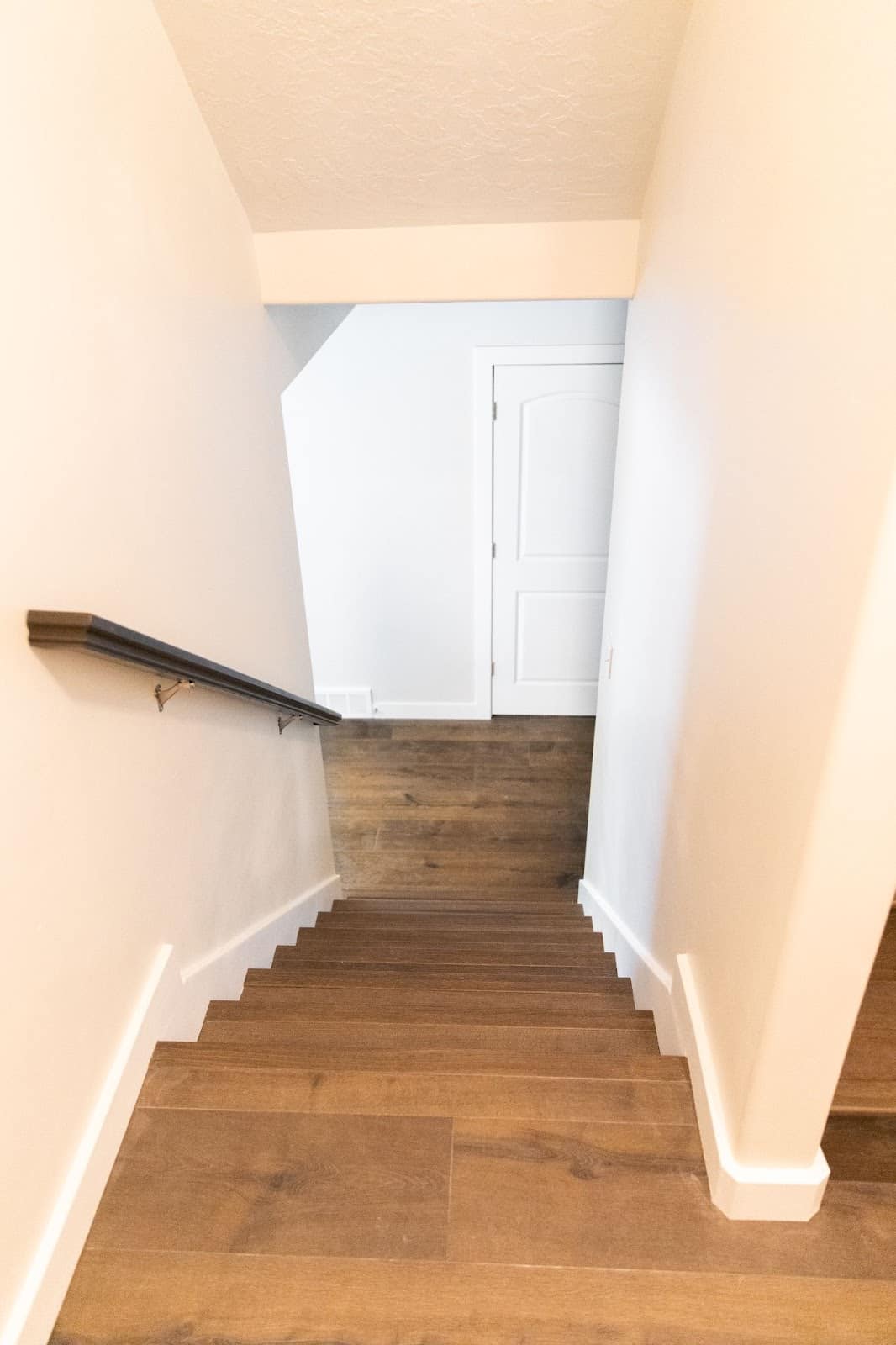
Renovating basement stairs involves several key steps, from the initial demolition to the final finishing touches. Understanding each phase helps homeowners manage the project more effectively and set realistic expectations.
The first step in any renovation is removing the old staircase. This phase is messy and noisy, involving the cutting, prying, and sometimes breaking of old materials. Homeowners should ensure the area is well-ventilated and safety measures are in place to handle debris and sharp objects.
Once the old stairs are out, examining and repairing any structural issues with the underlying framework is crucial. This might involve reinforcing joists, repairing or replacing stringers, and ensuring everything is level and secure. These repairs are vital for the longevity and safety of your new stairs.
With the structure secure, the next step is to install the new stair treads and risers. Depending on the materials and design, this could be a straightforward renovation process or require custom fittings, especially for materials like concrete or intricately designed wood stairs.
Safety is paramount in stair design. This phase involves installing handrails, balusters, and additional safety features like non-slip treads or extra lighting. Ensure all elements comply with local building codes to provide safe and accessible passage.
The final phase of the renovation includes painting, staining, or sealing the stairs, depending on the chosen materials. This enhances the aesthetic appeal and protects the materials from wear and moisture, which is particularly important in a basement setting.
After the construction and finishing work are completed, a thorough cleanup will make the space ready for use. Removing all construction debris and cleaning the stairs will ensure they look their best and are safe to use.
Integrating essential safety features and ensuring compliance with local building codes are critical to creating a safe and legal home improvement when renovating basement stairs. This section will guide you through the critical safety components and regulatory standards to consider.
Handrails provide stability and support for navigating stairs, making them indispensable, especially in a basement setting with limited lighting.
Install them at a consistent height that matches local code requirements, typically between 34 and 38 inches above the stair treads. Balusters supporting the handrail must be spaced closely enough (usually no more than four inches apart) to prevent small children from slipping through.
The tread depth and riser height of your stairs must meet specific dimensions to ensure ease of use and safety. Standard practice dictates a minimum tread depth of 10 inches and a maximum riser height of 7.75 inches. These measurements vary, so it's essential to consult your local building codes to confirm the exact requirements in your area.
Local building codes are designed to ensure safety and accessibility in home construction, including stair design. These codes address various aspects of stair construction such as width, slope, and load capacity. Compliance not only ensures safety but also facilitates smooth inspections and boosts the overall integrity and value of your home improvement projects.
When planning your staircase, consider the needs of all users, including children, the elderly, and individuals with limited mobility. Features like additional lighting, tactile surfaces on stair treads, and visually contrasting materials greatly enhance safety and usability.
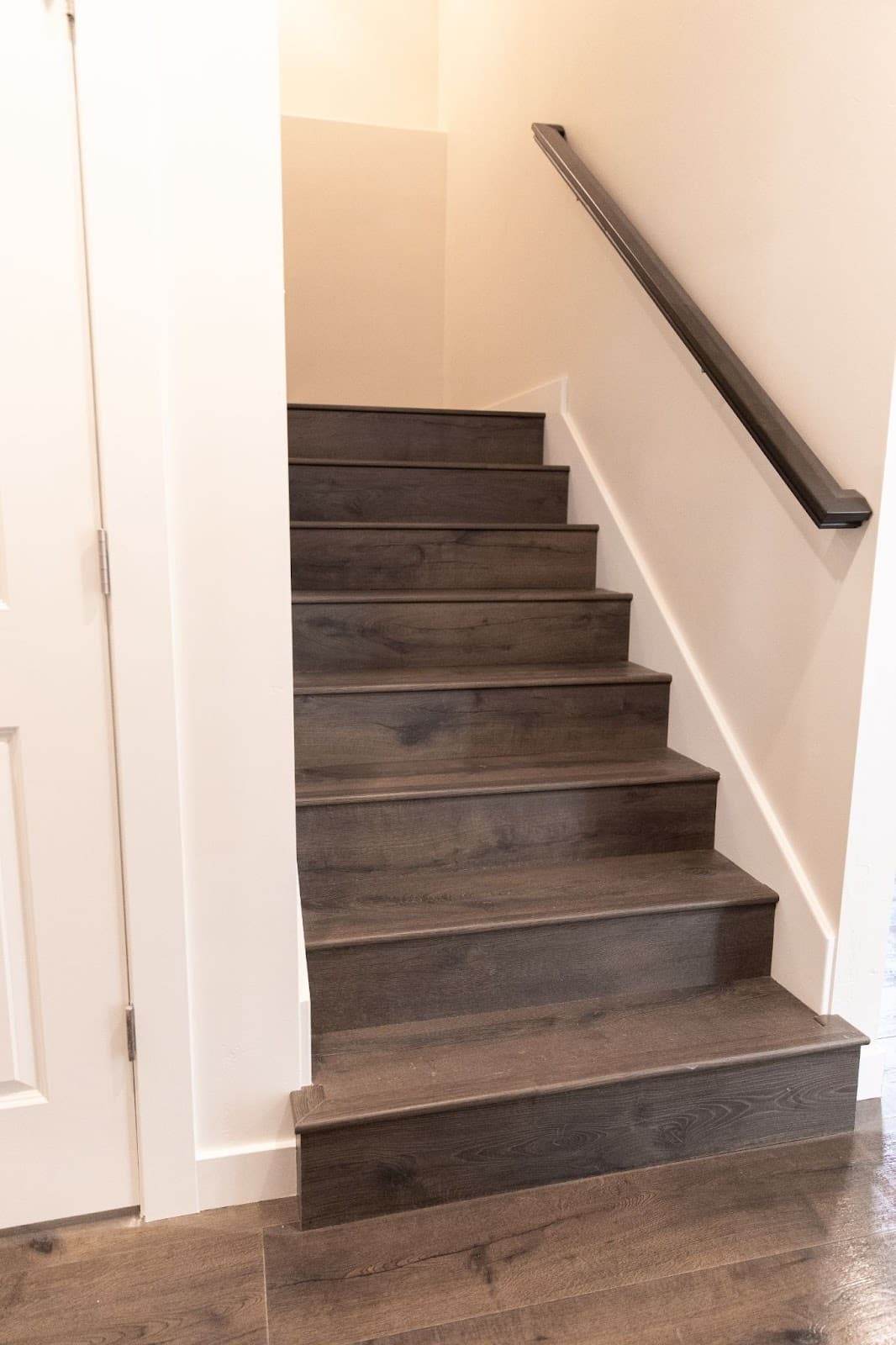
Renovating your basement stairs significantly enhances your home's safety, functionality, and style. At CCS of Utah, our team excels in transforming basic staircases into remarkable features, ensuring each step of the process, from design to installation, meets your specific needs while adhering to safety standards.
Choose CCS of Utah for expert guidance, superior craftsmanship, and innovative design. Let us help you create a staircase that is not only safe and stylish but also a standout element of your home’s interior. Contact CCS of Utah today to begin your basement stair renovation and take the first step towards a safer, more elegant home.
Creating a basement game room is a popular way to boost your home's value and establish a vibrant entertainment hub.
This blog outlines the essential features that transform a basement from functional to fantastic. Whether you're a gamer, a movie lover, or a game night host, understanding how to blend practicality with enjoyment is crucial. We'll cover everything from top-notch audiovisual setups and comfy seating to the right lighting and stylish decor.
Dive into the key elements that make a basement game room dynamic and welcoming, maximizing every inch for ultimate fun and function.
An immersive audio experience is crucial for enhancing the enjoyment of games and movies, making a high-quality sound system essential for any game room.
A surround sound system with multiple speakers creates a theater-like audio environment, enveloping the listener from all directions. Consider systems with a subwoofer for deep bass and satellite speakers that you can mount on the wall to minimize clutter.
Additionally, incorporating acoustic paneling greatly improves sound quality by reducing echo and absorbing noise, which is especially beneficial in basements with hard surfaces. These panels improve acoustics and enhance the room's aesthetics.
The right combination of surround sound and acoustic treatment will transform your basement into a hub for immersive entertainment.
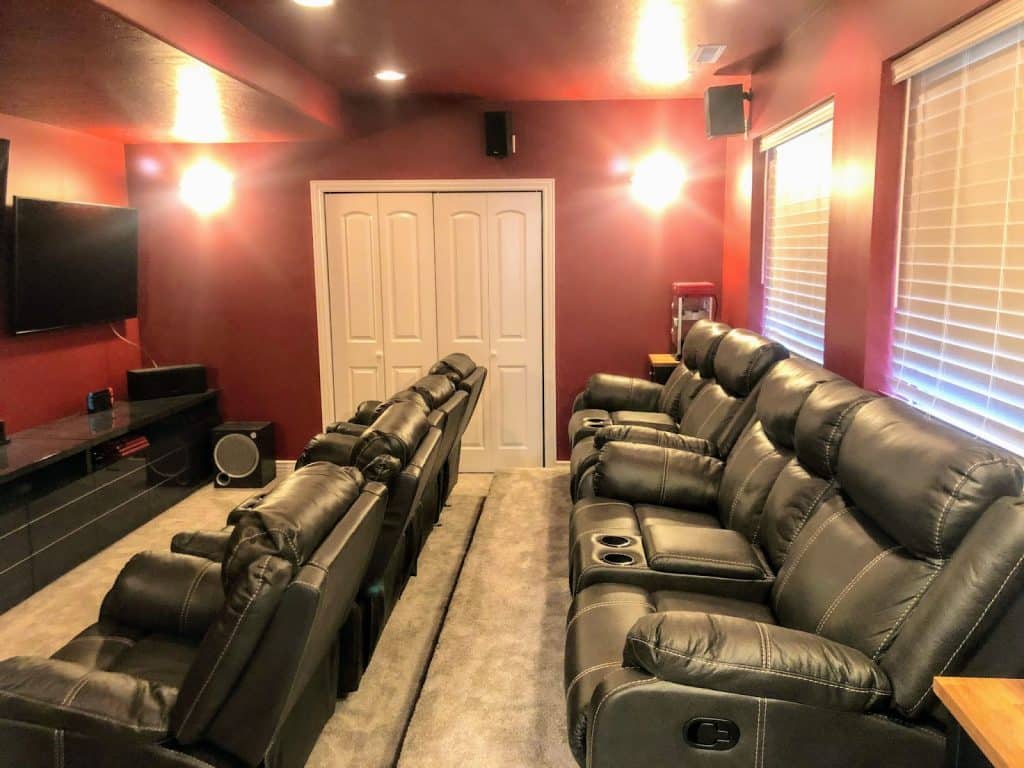
Comfortable seating creates an inviting basement game room for long entertainment sessions. The right seating choices transform your basement into a welcoming area for video games, movies, or board games.
Consider versatile and comfortable options like sectional sofas that provide flexible group arrangements. These recliners offer luxury and relaxation with adjustable positions and gaming chairs designed for ergonomic support and extended play sessions.
Strategically arrange seating to ensure every spot has a clear view of the TV or monitors, with seats placed at a comfortable distance — typically three times the height of your TV screen. A slightly curved seating arrangement enhances viewing angles and makes everyone feel included.
If space permits, create varied seating zones with bean bags or floor pillows for casual gaming and structured areas with sofas and chairs for socializing and viewing. This approach optimizes functionality and accommodates different comfort preferences, ensuring your game room is enjoyable for any activity.
Effective lighting is key to enhancing the ambiance and functionality of your basement game room. It is important for setting the mood and reducing eye strain during prolonged gaming or movie sessions.
Dimmable overhead lights are essential due to their versatility, allowing adjustment of brightness to match various activities and reduce glare on screens.
Additionally, LED strip lighting is a dynamic option, providing a subtle glow that enhances the atmosphere without overwhelming brightness. Install these lights behind monitors or under furniture, highlighting room features and focusing attention on areas like shelving or gaming stations.
For tasks requiring more precision, like board games or card tables, focused task lighting is vital. Adjustable desk lamps or pendant lights over these areas ensure clear visibility of game pieces and cards, boosting playability and comfort.
Choosing the right flooring for your basement game room is essential for aesthetics, durability, and easy maintenance. Laminate, vinyl, and carpet tiles are robust options well-suited for the challenges of game room environments.
Laminate flooring is famous for its resilience, wide range of finishes, and easy maintenance. It's scratch-resistant, mimics more expensive materials like hardwood, and is straightforward to install, making it ideal for high-traffic areas.
Vinyl flooring excels in durability and moisture resistance, which is crucial for basement settings. It offers comfort underfoot, comes in various styles, and enhances room acoustics by dampening sound and reducing echo.
Carpet tiles provide comfort and effective sound absorption, making them perfect for extended gaming sessions without disturbing others. Their modular nature allows you to easily replace individual times if they get damaged.
When selecting flooring, consider its visual appeal and functional benefits, such as acoustic properties and moisture resistance. Whether you choose laminate for its appearance, vinyl for its resilience, or carpet tiles for its comfort, the right flooring will enhance the functionality and enjoyment of your game room.
Incorporating multiple screens or TVs in your basement game room improves its versatility and entertainment value. This setup allows various activities like gaming and movie watching to co-occur, catering to different interests, keeping everyone engaged, and making the game room a prime entertainment hub.
Multi-screen setups benefit gaming enthusiasts by enabling multiplayer sessions without the need to split a single screen, preserving the quality of the gaming experience. Movie lovers can watch films uninterrupted, while others engage in different activities on additional screens, adding flexibility and continuous entertainment.
Effective screen placement will help you optimize the viewing experience. Arrange screens at eye level to prevent neck strain and maintain an ideal viewing distance of about 1.5 times the screen's diagonal size to avoid eye strain. Consider seating layout to ensure optimal sightlines from all angles.
When installing multiple TVs or monitors, consider the wiring and connectivity needs. Ensure easy access to power outlets and employ cable management solutions to maintain an organized space. Swivel mounts offer the flexibility to adjust screens for different viewing angles and audience sizes.
Also, manage the acoustic effects of multiple screens. If the sound overlap is a concern, consider using wireless headphones for individual gaming stations or sound bars with directional sound to keep audio-focused and clear. This thoughtful technology integration ensures a smooth and enjoyable experience for all users.
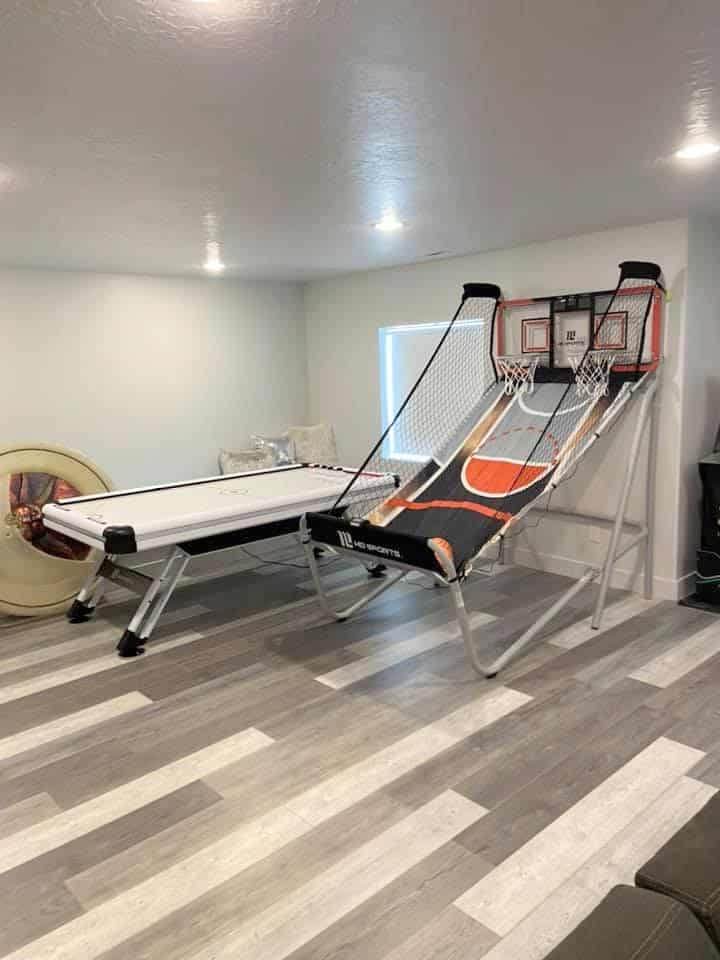
Adding diverse gaming tables like pool, foosball, and ping pong increases the appeal and versatility of your basement game room, catering to various interests and ages.
A pool table serves as a stunning centerpiece that enhances the room's aesthetics and provides hours of engaging play, helping to create a classic game room atmosphere. Foosball tables offer dynamic, fast-paced gameplay ideal for friendly competitions, while ping pong tables introduce active, reflex-based games suitable for all ages, encouraging physical activity and social interaction.
Space-saving options like convertible or foldable gaming tables are practical solutions for smaller spaces. Convertible tables allow flexibility by serving multiple purposes on one surface — for example, switching from a pool table to a ping-pong table. You can stow foldable tables away when not in use, optimizing space efficiency.
When setting up these tables, ensure they are strategically placed to allow ample room for movement around each table, enhancing comfort and functionality. This thoughtful arrangement turns your game room into an inviting space where family and friends are drawn to gather and engage.
A dedicated snack and beverage bar will transform your basement game room into a self-contained entertainment hub, boosting its usability and social appeal. This feature allows guests to easily access drinks and snacks without stepping away from the fun and serves as a central spot for socializing and relaxation.
Start by installing a mini fridge to keep beverages and perishable items chilled and accessible, ensuring guests always have refreshments on hand. If room permits, add a bar counter where guests can gather, chat, and enjoy their snacks, and use this area as additional serving space for parties or gatherings.
Incorporate storage solutions such as cabinets or shelving units under or above the bar counter to organize snacks, glasses, and other essentials. Open shelving can also display decorative items or snacks, enhancing the room’s decor while keeping supplies within reach.
When designing your snack and beverage bar, ensure it complements your game room's overall layout and design, using materials and colors that blend with the existing decor. Consider adding practical features like trash receptacles and recycling bins nearby to keep the area clean and convenient.
Themed decor significantly enhances the atmosphere of a basement game room, transforming it into a personalized retreat that reflects the interests and passions of its users. Whether video game icons for gamers, vintage game boards for board game enthusiasts, or classic cinema memorabilia for movie lovers, each theme adds a unique touch that personalizes the space.
Choose color schemes and materials that complement the overall decor to ensure the game room feels integrated rather than disjointed from the rest of your home. For modern homes, opt for sleek, minimalistic styles, while rustic homes benefit from natural woods and warm tones.
Integrating modern technology into your basement game room enhances functionality and ease of use, creating a seamless interactive environment. Smart home systems streamline the control of lighting, sound, and climate, significantly improving the user experience.
With a few taps on a smartphone or simple voice commands, you can dim the lights, adjust the volume, and change the temperature, optimizing comfort and ambiance without interrupting gameplay or movie watching.
Additionally, installing charging stations is crucial to keep devices like smartphones and gaming controllers powered and ready for use. Place charging stations strategically around the room, near seating areas or gaming consoles, to ensure easy access without adding clutter.
Effective cable management is essential to maintaining a tidy and safe environment. Cable organizers, clips, and conduits help manage and conceal wires, preventing tangles and reducing hazards. This organization enhances the room's aesthetics and simplifies cleaning and maintenance.
Elevate your basement game room with CCS of Utah. Our expert team specializes in integrating high-quality sound systems, comfortable seating, advanced tech, and thematic decor to create a dynamic entertainment space tailored to your preferences. We provide expert advice, premium materials, and innovative designs, transforming your game room into a hub of enjoyment that enhances your home life and adds value to your property. Contact CCS of Utah to start crafting your dream game room with precision and passion.
The trend of transforming basements into rental units has accelerated as homeowners discover innovative ways to tap into their property's potential. This approach boosts income and property value while providing tenants with affordable, uniquely designed living spaces.
We'll explore space-efficient layouts, smart technology enhancements, and stylish decor tips that elevate these areas far above the typical basement feel. Covering everything from basic design to final touches, we guide you on how to make your basement a highly sought-after rental property.
These transformative ideas enhance living spaces and maximize your investment in the lucrative basement rental market.
Creating an efficient layout is essential for enhancing both the appeal and functionality of a basement rental. Opting for an open-plan design that integrates living, dining, and kitchen areas helps make the basement feel spacious and welcoming.
Such layouts improve the flow and visual coherence of the space, making it appear larger. Incorporate elements like a central island that doubles as a dining area and additional workspace, or a pull-out pantry to maximize kitchen storage efficiently.
Built-in storage solutions also play a role in taking advantage of space without sacrificing style. Integrating shelves into walls, utilizing under-stair areas, and designing platform beds with drawers can increase storage capacity. Multi-functional furniture enhances a space’s functionality and appeal — like ottomans with hidden storage or couches that convert to beds.
These strategies help keep the living environment organized and clutter-free, a vital consideration in compact spaces like basements.
Creating a livable and inviting basement rental means enhancing the atmosphere and functionality of the space. Proper lighting and noise insulation are impact living quality significantly.
Basements typically lack natural light, leading to a dark and cramped atmosphere. To counter this, enhance any existing windows to allow more natural light, using light well covers to also protect against moisture.
In windowless areas, install bright, energy-efficient LED lights that simulate daylight. Utilize a variety of lighting fixtures, such as recessed lights, pendant lamps, and wall sconces, to create layered lighting. This strategy illuminates the space while defining different zones within an open layout, making the basement feel warmer and more inviting.
Effective soundproofing is crucial, especially in basements that share a building with upstairs living spaces. Implementing robust noise insulation maintains privacy and tranquility, enhancing comfort for tenants and minimizing disruption for homeowners. Insulate floors, walls, and ceilings with materials designed for sound reduction, like acoustic panels or sound-absorbing foam.
Use thick carpets and padded underlays to further dampen noise. Consider a suspended ceiling system that facilitates the easy addition of acoustic insulation. These measures ensure a quieter living environment for tenants and prevent noise from traveling to other parts of the home, supporting peaceful coexistence.
Optimizing kitchen and bathroom functionality is key in crafting an efficient and stylish basement rental. Here’s how to enhance these spaces with smart design choices that maximize both utility and aesthetics.
In compact basement kitchens, every inch matters. Choose ergonomic designs that meld functionality with style. Install space-saving appliances like slim refrigerators, compact dishwashers, and combination microwave and oven units designed for small spaces.
Incorporate pull-out counters or drop-down table extensions to expand prep and dining areas. Use deep drawers and vertical storage solutions to increase storage while keeping countertops clear. Light-colored cabinets and backsplashes make spaces feel bigger, and under-cabinet lighting ensures work areas are well-lit.
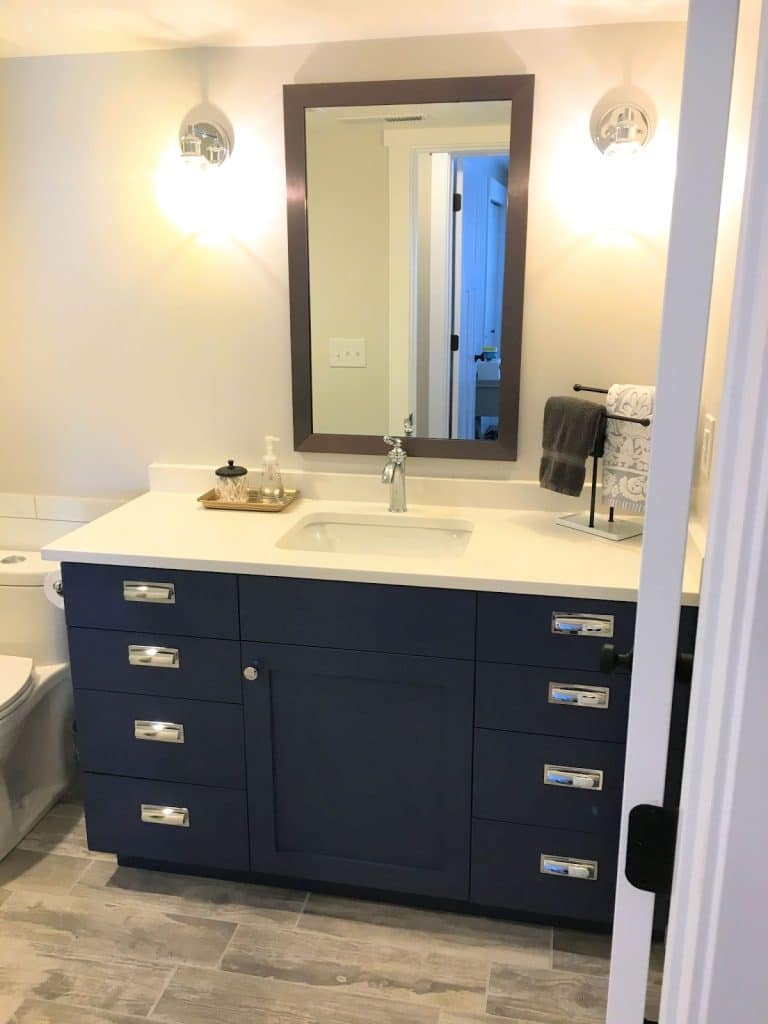
Design bathrooms to fully utilize small spaces without compromising on style or function. Install corner showers to conserve space while maintaining a modern aesthetic. Use wall-mounted toilets and sinks to enhance the sense of openness and simplify cleaning.
Opt for floating shelves for accessible toiletry storage and mirrored medicine cabinets to serve dual storage purposes and enhance light reflection. Choose light colors and large tiles to visually expand the space. Ensure the bathroom is well-ventilated to prevent moisture buildup.
Integrating smart home technology boosts the appeal of a basement rental, particularly for tech-savvy tenants who prioritize convenience and efficiency. Here’s how to incorporate automation, security features, and energy-efficient upgrades effectively.
Modern renters value homes that combine comfort with security and easy management. Installing smart home systems to control lighting, heating, and security enhances your basement rental’s attractiveness.
Automated lighting systems let tenants adjust light settings via smartphones, tailoring the ambiance to their preferences. Smart thermostats maintain optimal temperature while minimizing energy use and can be adjusted remotely to welcome tenants into a comfortable environment anytime.
For enhanced security, consider smart locks and security cameras that connect to mobile apps, providing real-time monitoring and peace of mind.
Implementing energy-efficient features benefits both the planet and your pocketbook. LED lighting, which consumes less energy and lasts longer than traditional bulbs, reduces energy costs and maintenance needs.
Energy Star-rated appliances attract eco-conscious renters by using less electricity and water than standard appliances. Proper basement insulation prevents heat loss, maintains a comfortable living environment, and further decreases heating costs.
These upgrades lower utility bills, making the rental more appealing, and position your property as environmentally responsible — a growing concern for many tenants today.
Creating a welcoming and visually appealing basement rental goes beyond functional design; it’s about selecting the right decor and furniture to enhance the living experience. Here are some tips for choosing decor that maximizes space perception and offers flexible, stylish furniture options.
The decor choices you make transform a basement from a simple sub-level space into an inviting living area.
Begin with the color scheme; opt for light, neutral colors like soft grays, warm whites, and pastels to make small spaces appear larger and brighter. Use mirrors strategically to expand the visual space and reflect light throughout the room, which is particularly effective in dimly lit areas.
Employ vertical lines through striped wallpapers or tall, slender furniture to draw the eye upward and create an illusion of height. Add elements of elegance such as vibrant cushions, bold lighting fixtures, or unique artwork to enhance the decor without overwhelming the space.
Flexibility is crucial in a rental space. Choose furniture that serves multiple purposes or is rearrangeable to accommodate various needs.
Foldable desks or tables work well for tenants who require an office set up by day that quickly reverts to living space at night. Sofa beds are ideal for accommodating guests and maintaining functionality without dedicating space solely for sleeping.
Opt for ottomans with built-in storage that function as seating, coffee tables, or concealed storage. Selecting versatile furniture conserves space and offers practical benefits, making the rental more adaptable and functional for diverse living situations.
Transforming a basement into a rental unit requires careful navigation through a complex set of legal requirements to ensure safety and compliance with local regulations. Here’s how to effectively manage building codes, permits, and essential safety measures.
To convert a basement into a livable space, you must adhere to specific building codes that confirm the structure's safety and suitability for occupancy.
Consult your local building department to understand the applicable codes and regulations. You will need to secure permits before starting any significant construction or renovation. This involves submitting detailed plans and undergoing inspections both during and after the work to ensure compliance.
Proper permitting legalizes your renovation while guaranteeing the correct installation of structural, electrical, and plumbing systems.
Safety is crucial in designing any living space, especially basements, which present unique challenges. Install adequate egress windows to provide safe exits during emergencies; these windows must be large enough for an adult to exit easily and positioned at an accessible height.
Proper ventilation is also critical to prevent dampness and mold, which are common in basement environments. High-quality ventilation systems maintain air quality and prevent moisture buildup.
Moreover, installing smoke detectors and carbon monoxide detectors is mandatory, enhancing safety by providing timely alerts in case of fire or gas leaks.
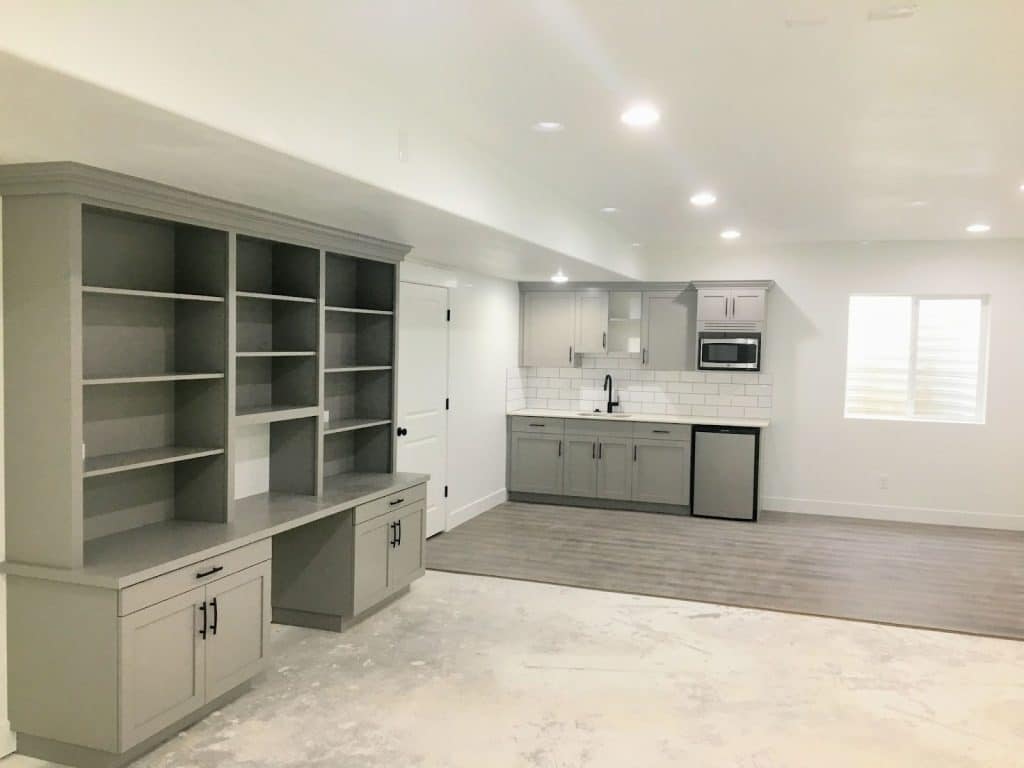
For homeowners looking to navigate the complex process of creating a basement rental with ease, partner with CCS of Utah.
Our experienced team is adept at handling every aspect of basement renovations, from initial design concepts to detailed execution that meets all local building codes. We ensure that your project exceeds your expectations while it complies with all regulatory requirements, guaranteeing a safe, stylish, and functional living space.
Trust CCS of Utah to transform your basement into a thriving rental space that tenants will love and serve as a valuable asset for years to come.
Get a quote or contact CCS of Utah today and take the first step toward maximizing your home’s potential with a professionally remodeled basement that stands out in the competitive rental market.
Basement renovations are a hot topic among homeowners. They are often seen as a promising way to transform underused square footage into vibrant, functional living spaces. Many choose to renovate their basements to meet growing family needs, add value to their homes, or simply make better use of what is frequently wasted space.
The possibilities are as varied as they are enticing, from creating cozy family rooms to stylish home offices or even self-contained rental units.
In today’s blog, we'll explore the benefits and potential pitfalls of undertaking a basement renovation. Our goal is to arm you with important insights that will help you determine whether this significant home improvement aligns with your lifestyle needs and financial goals.
By weighing the advantages against the drawbacks, you'll be better equipped to make an informed decision about transforming your basement into a cherished part of your home. See what it takes to turn that dark, underused space below your feet into a bright and valuable asset.
One of the most compelling reasons to renovate a basement is its substantial increase in usable living space. Renovated basements offer many options for growing families or those seeking to declutter their main living areas.
Transform this often-underutilized space into anything from a vibrant home office where focus and productivity flourish, to a dynamic gym where you sweat out the day's stress. Entertainment areas, such as home theaters or game rooms, also make excellent additions, turning the basement into a hub of enjoyment for family and friends.
A well-planned basement remodel boosts your home’s market value. When potential buyers see a finished basement that’s both functional and attractive, it often increases the property’s appeal, making it stand out in the competitive real estate market.
This expanded space isn't simply another room; it's viewed as an extension of the usable living area, which is a strong selling point that commands a higher price.
If your local zoning regulations allow, converting your basement into a rental unit provides a steady source of additional income.
This setup works particularly well in homes with separate entrances for the basement, allowing tenants privacy without disrupting the homeowner’s daily activities. Such arrangements become incredibly lucrative in areas with high rental demand, offering financial benefits that help offset mortgage payments or fund other home improvements.
Basements are versatile; you can customize them to suit various needs and preferences. Whether you envision a quiet wine cellar, a lively craft room, or a comfortable in-law suite, the possibilities are virtually limitless. This flexibility allows homeowners to tailor the space to their specific lifestyle requirements, making basements a truly unique and valuable component of the home.
Through these various advantages, basement renovations stand out as a wise investment for those looking to enhance their living space, increase property value, generate income, or simply create a more functional and personalized home environment.
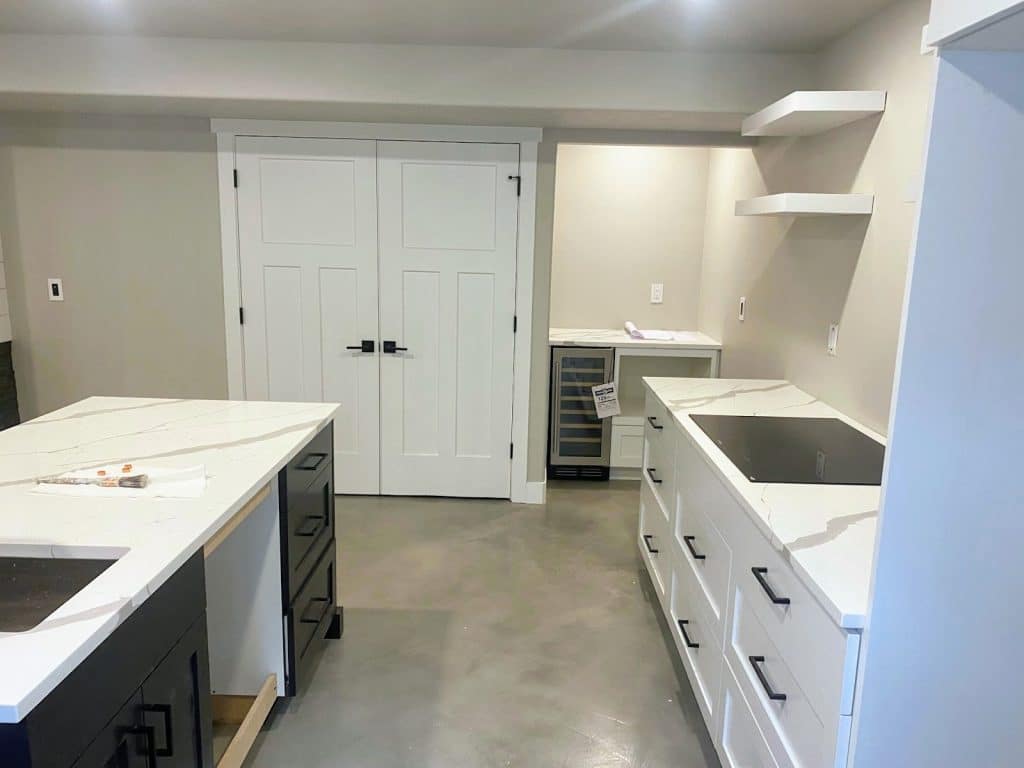
Renovating a basement elevates an underused area of your home into a vibrant, functional space. However, it’s not without its challenges and costs. Homeowners need to understand the drawbacks before considering this substantial home improvement.
One significant hurdle is the high initial costs. Basement renovations are expensive due to the extensive work often required to make the space livable. This includes basic cosmetic changes and major structural, electrical, and plumbing updates necessary to meet current living standards.
For example, older homes might need significant modifications to their foundational structure or new plumbing lines to accommodate an additional bathroom.
Moisture and ventilation are other critical issues that need careful consideration. Basements are prone to dampness due to their below-ground location. Without proper waterproofing measures, such as installing sump pumps or French drains, moisture seeps in, leading to mold and mildew problems that compromise air quality and can be costly to remediate.
Adequate ventilation systems are essential to ensure that the air remains fresh and healthy, and this requires additional planning and expense.
The complexity of construction is also a factor that deters homeowners. Many basements have inherent challenges, such as low ceilings, limited access, and complex foundational structures that may require creative solutions to optimize the space. These obstacles often necessitate innovative design and construction techniques, which increase the project's cost and duration.
Finally, the need for permits and strict adherence to local building codes further complicate basement renovations. Depending on where you live, securing the necessary permits is a time-consuming process that involves detailed inspections and potential revisions to your plans to ensure compliance with local regulations.
This extends the timeline of your renovation project but also adds to the overall cost, as you might need professional assistance to navigate these legal complexities.
While basement renovations enhance your home and lifestyle, they require careful planning and consideration of potential issues. Awareness of these challenges helps you set realistic expectations and prepare adequately for transforming your basement into a cherished part of your home.
When considering a basement renovation, evaluating its return on investment (ROI) explains how this upgrade compares financially to other home improvements. Several factors contribute to the ROI of a basement remodel, and understanding these helps you make a more informed decision about proceeding with your project.
The quality of work significantly affects the ROI of any basement renovation. High-quality craftsmanship and materials ensure the durability and aesthetic appeal of the finished space but also appeal more to potential buyers, should you choose to sell your home.
A professionally finished basement that complements the overall style and functionality of the house offers a substantial return. In contrast, a poorly executed project might not recoup its costs and could even detract from the home's value.
The location of your home also plays a pivotal role in determining the ROI of a basement renovation. Homes in high-value or rapidly appreciating real estate markets tend to gain more from basement remodels because additional livable space is at a premium. Conversely, in areas where market values are stagnant or falling, the return on investment might not justify the initial expense.
The current real estate market conditions greatly influence the ROI. In a seller’s market, where demand outstrips supply, a well-renovated basement boosts a home’s appeal and selling price. In a buyer’s market, however, potential buyers might have more options and could be less willing to pay a premium for a renovated basement, affecting the overall ROI.
Comparing the potential ROI of basement renovations to other home improvements also offers valuable insights. For instance, kitchen and bathroom remodels are traditionally seen as some of the best ways to add value to a home, often providing a higher average return on investment than basement renovations.
However, the added square footage of a finished basement may be a bigger draw in areas where families are looking for more living space. This makes basement renovations particularly competitive in terms of ROI, mainly if they include additional bathrooms or specialized areas like home theaters or gyms that attract a broader audience.
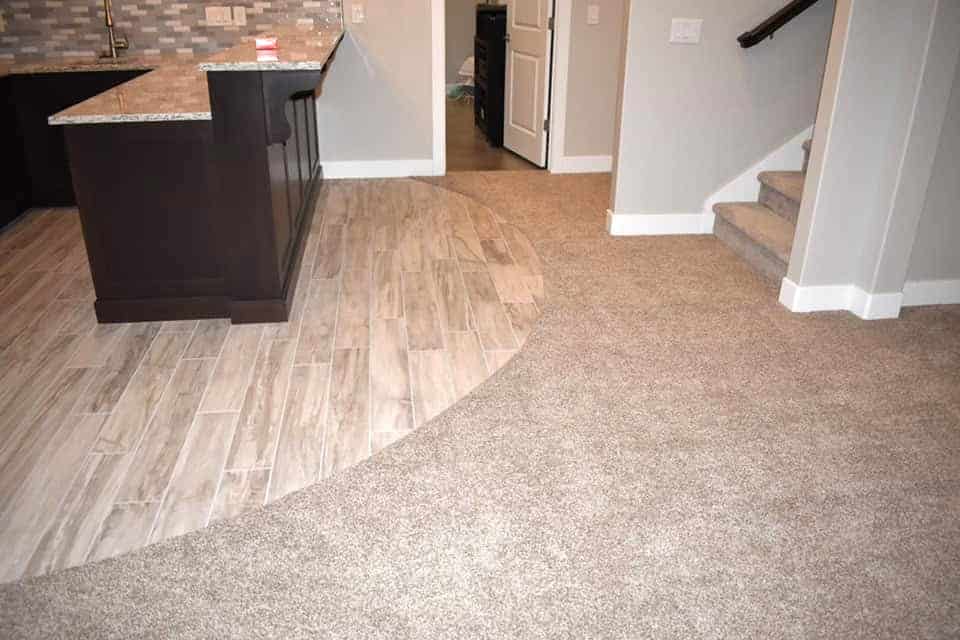
Deciding to renovate your basement is a major undertaking that requires careful thought and planning. As you weigh the pros and cons, consider the impact on your living space, evaluate the potential return on investment, and reflect on how well the renovation aligns with your personal needs and future plans. With all factors considered, the next step is choosing the right project partner.
At CCS of Utah, we understand that a basement renovation is more than a construction project — it's an opportunity to enhance your home life and increase your property's value. Our team is committed to providing high-quality craftsmanship tailored to meet your specific desires and needs.
We stand ready to guide you through every step of the process, ensuring that your basement transformation is smooth, stress-free, and perfectly aligned with your vision. Our expertise in managing both the complexities of construction and the nuances of design makes us the ideal choice for your renovation project.
Reach out to CCS of Utah today, and take the first step toward transforming your basement into a beautiful and functional space that you and your family will enjoy for years. Together, we will create a space that meets your current needs and adapts to your future aspirations.
A well-executed basement remodeling project dramatically expands your living space and boosts your home's value. Whether you envision a vibrant playroom for the kids, a sleek new home office, or a cozy den for movie nights, remodeling your basement unlocks many possibilities.
We’re here to provide you with essential knowledge and tools to navigate the renovation process confidently. From understanding cost factors to optimizing your investment, we'll help you through every planning phase to transform your basement into a beloved and functional part of your home for years to come.
Many homeowners' primary motivation for a basement remodeling project is the need for more living space as families grow and needs change. Homeowners often add bathrooms to boost functionality and value, design home theaters for an immersive entertainment experience, or create guest rooms that offer comfort and privacy without upending daily life.
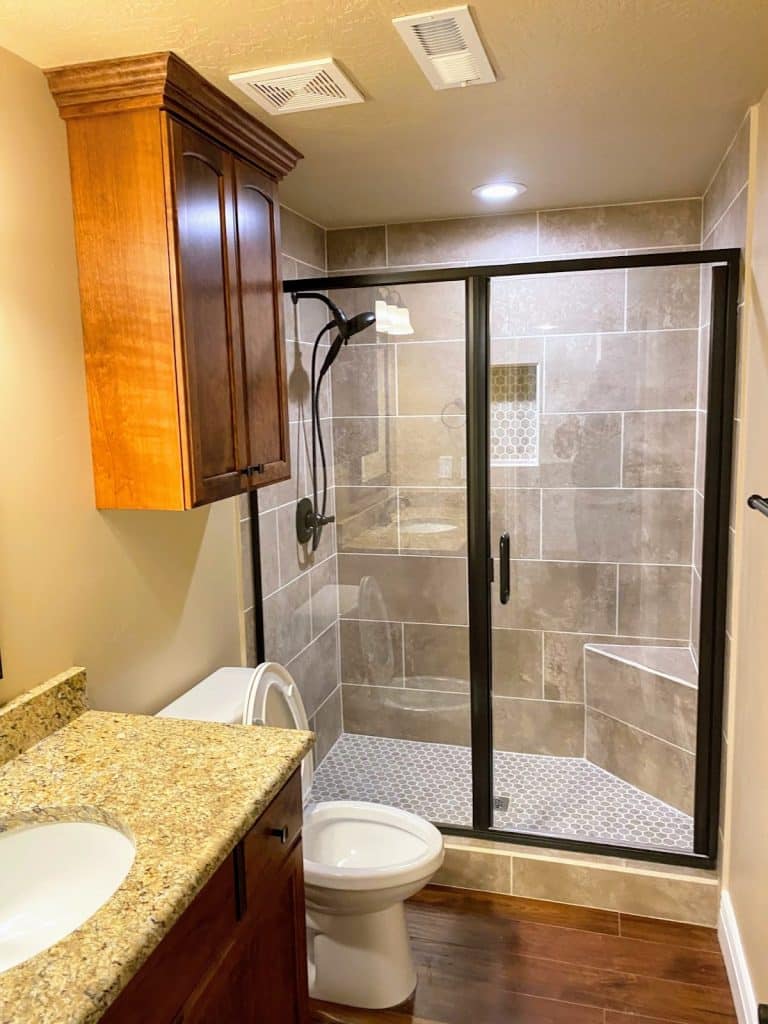
These upgrades make your home more enjoyable and adaptable to various needs, ensuring your newly remodeled basement is inviting and practical.
Start your basement remodel with a clear definition of the project scope. What is your vision for the space? Whether adding an extra bedroom, a home gym, or a versatile family room, knowing the intended purpose helps you identify essential features such as soundproofing for a home theater, moisture-resistant bathroom materials, or durable gym flooring.
Detail the key elements that will bring your vision to life, like built-in storage, specific lighting, or custom cabinetry. A comprehensive list of these features aids contractors in providing accurate quotes and helps avoid costly mid-project adjustments.
A crucial step is understanding the local building codes and necessary permits, especially for structural changes or electrical and plumbing work. Familiarize yourself with your municipality’s regulations to prevent any legal issues that could delay your project. Consulting your local building department’s website or scheduling a meeting to discuss your project is often invaluable.
Contractors start by inspecting your basement to identify potential issues that could impact the remodel. Examples include moisture and structural integrity. These initial evaluations check the feasibility and safety of your planned changes.
Expect contractors to ask about your use of the space, material preferences, and overall goals for the remodel. Questions about your budget and timeline are also standard, as these influence the project’s scope and complexity. These inquiries help contractors gauge the necessary resources and potential challenges.
Contractors often offer different service tiers or options, allowing you to choose based on your budget and needs. Options might range from basic repairs and finishes to more extensive remodels with luxury features or custom designs, providing flexibility to match your financial and aesthetic preferences.
Understanding these key aspects of the quoting process enables you to engage confidently with contractors, ensuring you make well-informed decisions that align with your goals for a beautifully remodeled basement.
Understanding each part of the quote is important to ensure transparency and fairness in pricing. Here’s a concise guide on the typical components of a basement remodel quote and tips on how to read and compare these quotes effectively.
This usually forms the largest portion of the quote, covering the cost of physical work performed by contractors and their teams. Labor costs vary based on the project's complexity and the level of skill required.
Materials costs fluctuate depending on quality, availability, and whether they are standard or custom; the cost usually includes all necessary materials, from basic construction supplies to finishing elements like flooring and paint.
This cost is applicable if your project requires the services of an architect or interior designer, reflecting the complexity and uniqueness of your design.
These cover necessary permits for electrical, plumbing, or structural work as required by local regulations.
This may include expenses for dumpster rentals, debris removal, or other unforeseen costs related to making parts of your home usable during the remodel.
By comprehensively understanding and meticulously comparing quotes, you will choose a contractor who meets your budget but also aligns with your vision, ensuring the success of your basement remodel.
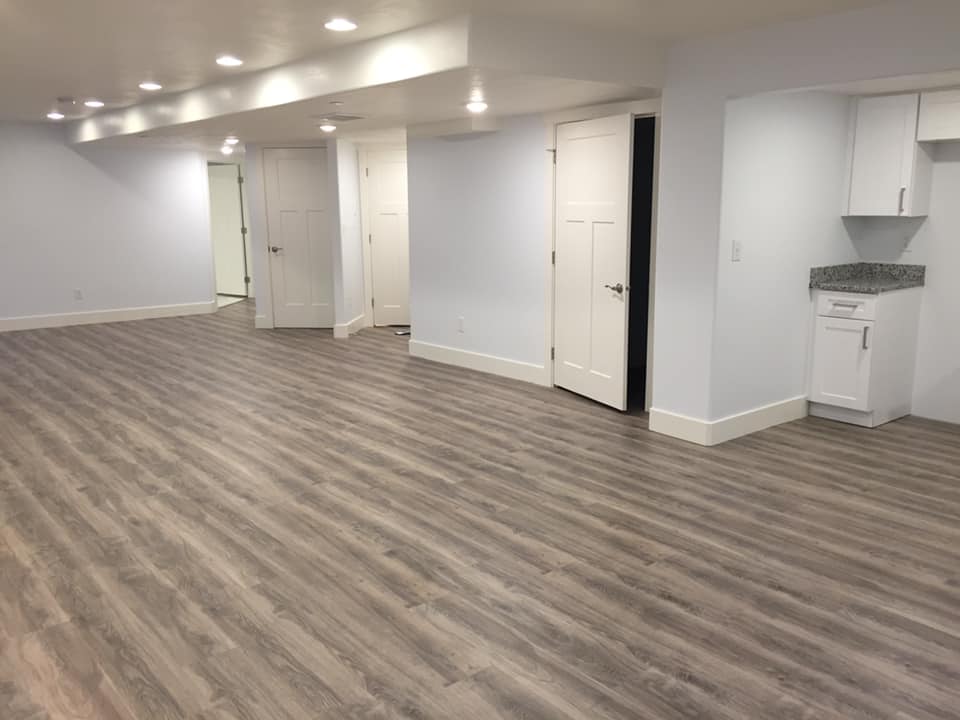
Start by defining the scope of your project — determine what you need versus what you desire. Gather multiple quotes from contractors to get a clear picture of potential costs. Break down your budget to include all expected expenses, such as materials, labor, design, and permits.
Always include an additional 10-20% of your total budget for unforeseen expenses. Unexpected issues like structural surprises, outdated wiring, or moisture problems may arise, and a contingency fund prevents these from derailing your project.
For significant projects, consider various financing methods:
These often offer lower interest rates and let you borrow against the equity in your home.
If favorable, refinancing your home may lower monthly payments while providing funds for your remodel.
These are viable for those without sufficient home equity, with varying rates and terms.
These are useful for smaller updates or quick repayments, especially cards with rewards or introductory 0% APR, but they generally carry higher interest rates.
Review your budget regularly as the project progresses. Track all expenditures, compare them against your estimates, and adjust your spending as necessary. Maintain open communication with your contractor about the financial status of your project.
Remodeling your basement offers an excellent opportunity to enhance your space without overspending. Here are effective strategies to achieve high-quality results while keeping costs down:
Opt for materials like luxury vinyl tile (LVT) or laminate countertops, which offer durability and style at a fraction of the cost of more luxurious materials. For example, LVT provides the look of wood or stone and is ideal for moisture-prone basements.
To save on labor costs, take on manageable tasks such as painting or installing trim. Leave more complex tasks like plumbing or electrical work to the professionals.
Consider repurposing fixtures from other parts of your home or buying second-hand. You can also refresh old cabinets with new paint and hardware for an updated look at minimal cost.
If the budget is tight, phase your remodel. Start with essential upgrades like electrical and plumbing, and gradually move to cosmetic changes as finances allow.
Always get multiple bids to ensure you're getting the best value. Understand what each quote includes to accurately compare and avoid hidden costs.
Invest in energy-efficient upgrades such as insulation and efficient lighting. These reduce long-term utility costs and are worth the initial investment.
Understanding the potential return on investment (ROI) and broader benefits will help you align your renovation with your financial and lifestyle goals.
The ROI from basement remodeling varies greatly based on the type and quality of the renovation. Generally, versatile living spaces like additional bedrooms or family rooms offer higher returns due to their broad appeal. Incorporating a bathroom also increases your home’s value and attracts potential buyers.
While more niche features like home theaters and custom bars target a specific market, they still provide a solid ROI if they appeal to luxury home buyers, setting your property apart in competitive markets. The most lucrative returns often come from creating separate living units with private entrances, which also provide rental income if local regulations permit.
Considering these aspects ensures that your basement remodel is an investment that pays dividends in both financial returns and enhanced living experiences, contributing significantly to your home’s appeal and your satisfaction as a homeowner.
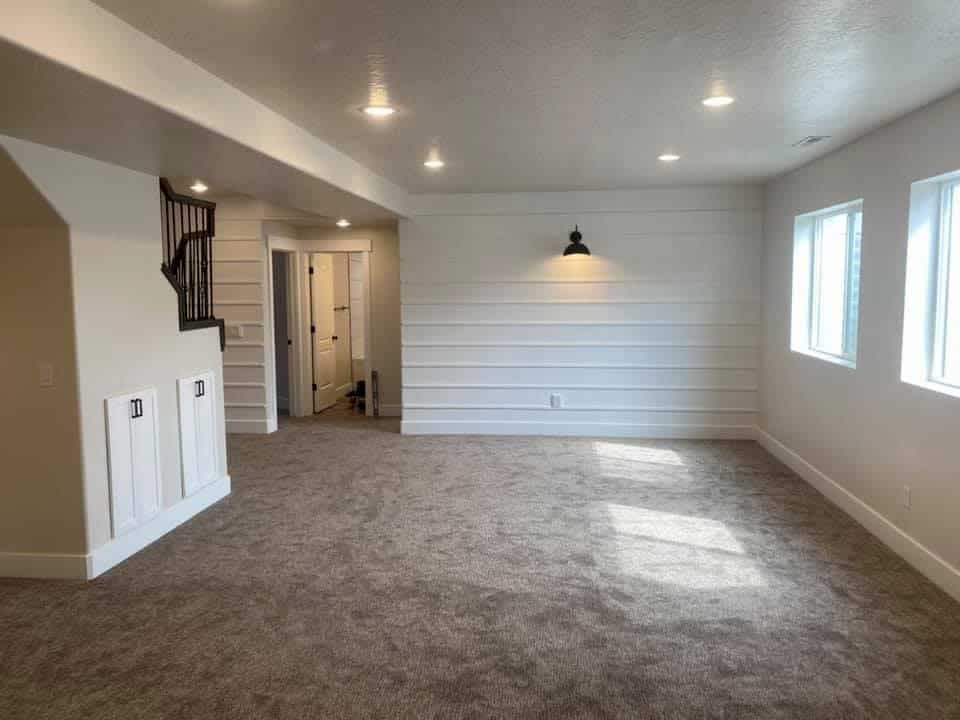
Whether you aim to add functional living space, design a cozy retreat, or boost your property's marketability, understanding every step — from obtaining quotes to setting a budget and assessing long-term ROI — is essential for success.
Get a quote and partner with CCS of Utah as you move forward with your remodeling plans. With our strong commitment to quality, customization, and client satisfaction, CCS of Utah is dedicated to transforming your basement into the space you've always envisioned. Our team of seasoned professionals will collaborate closely with you to ensure every aspect of the remodel meets your expectations.
Contact CCS of Utah today, and take the first step toward transforming your basement into a vibrant, functional part of your home. Together, we will tailor a remodeled basement that perfectly fits your lifestyle and budget.
Transforming your basement into the ultimate man cave is the quintessential way to carve out that special nook to retreat and relax in comfort. This guide will lead you to create the ultimate escape that perfectly resonates with your individual flair.
Get ready for us to guide you through every step, from wrapping your walls in comfort to hanging the last piece of décor.
Before transforming your basement into the ultimate man cave, start with a clear vision tailored to your interests, be it sports, gaming, or cinema. Use design software or sketch a layout to plan essential features like comfortable seating, a pool table, or a bar area.
Consider the space's flow to ensure easy access to amenities like a gaming console or a mini-fridge, and integrate personal touches such as team memorabilia or a popcorn machine for a personalized touch.
Measure and evaluate the layout and size of your basement, noting structural elements like support posts or low ceilings that might influence your design. Plan the placement of different activity zones, ensuring adequate ventilation and lighting, particularly if your basement lacks natural light or has concrete floors.
Choose a theme that reflects your personality, whether it’s a sports-centric hideaway, a cozy lounge, or a high-tech gaming zone. Use colors and textures to set the desired mood, and add elements like a vintage popcorn machine or sleek furniture to align with your chosen style. A well-thought-out theme transforms your basement into a personalized retreat.
Establish a realistic budget, including costs for essentials and extras, to ensure your project doesn't cause financial strain. Plan a flexible timeline to accommodate potential delays, prioritizing tasks to keep the transformation on track without added stress.
By planning thoroughly and considering every aspect from layout to theme and budget, you’ll create a man cave that perfectly suits your style and needs, making the process enjoyable and the outcome rewarding.
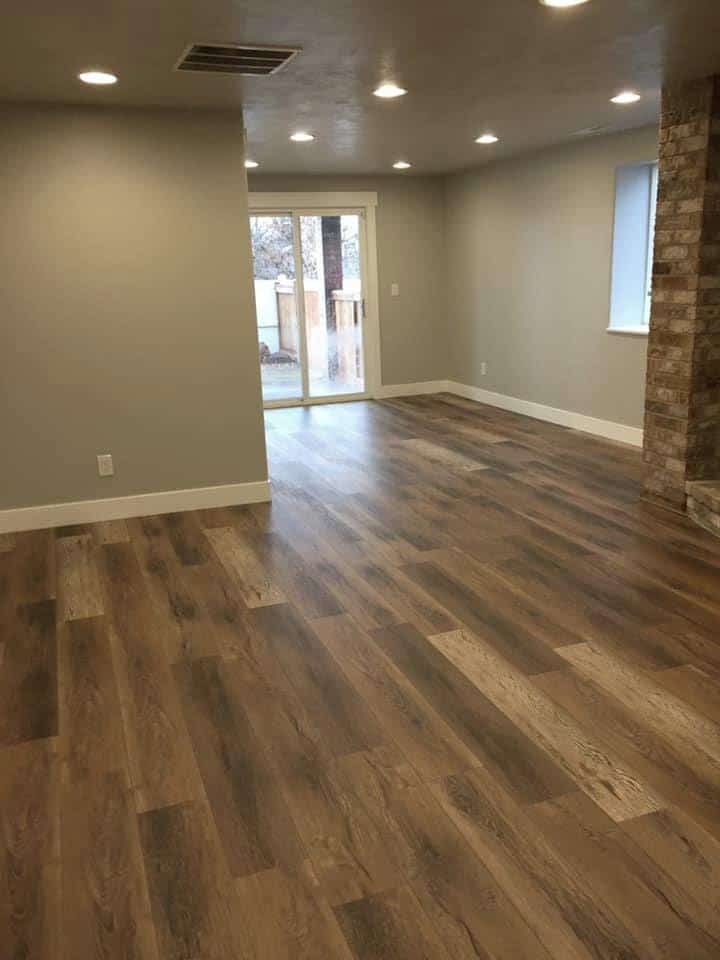
Creating the ultimate man cave is about crafting a perfect space with foundational elements like walls, flooring, and lighting.
Strong walls will hold your personal touches but also ensure proper insulation for temperature control and noise reduction. When choosing flooring, consider durable yet stylish options like laminate, vinyl plank, or engineered wood, which provide a polished look and withstand heavy use. Carpeting adds a cozy feel, which is ideal for movie nights or cheering on your team.
Effective lighting transforms your space with ambient lighting for overall brightness and task lighting for specific areas like game tables or seating. Accent lighting enhances features like bars or gaming tables, while dimmer switches allow you to adjust the mood from bright for games to dim for movie viewing.
Smart lighting adds a layer of convenience, enabling you to control settings from your console or smartphone, perfectly tailoring the environment for any activity in your man cave.
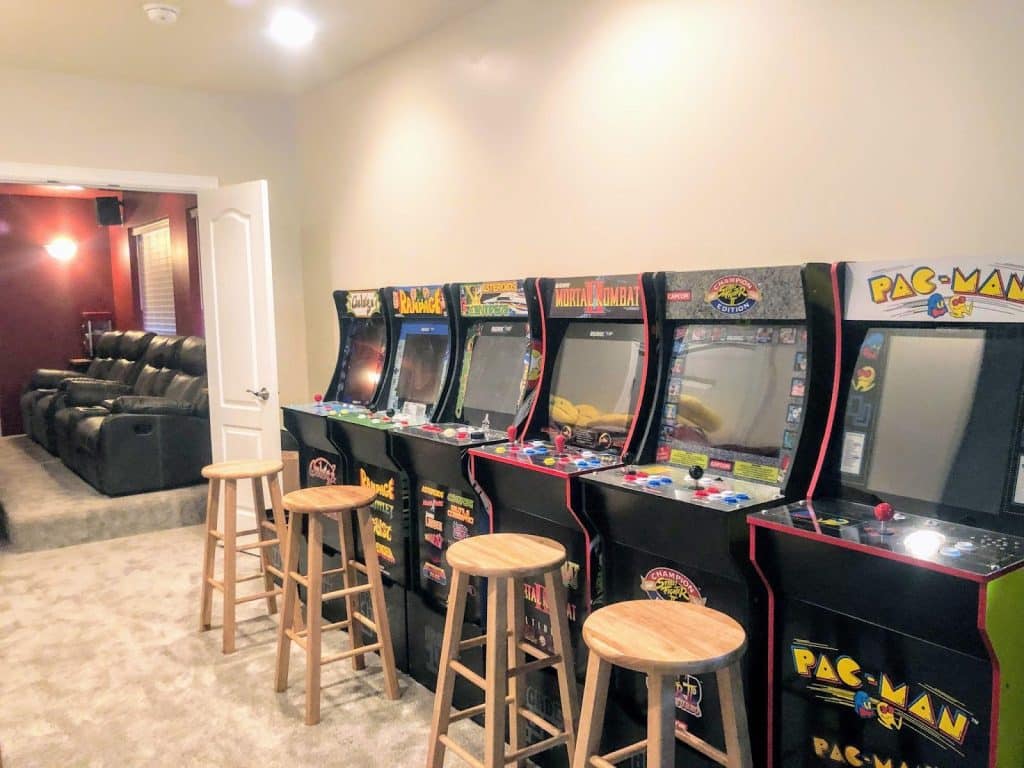
The heart of the ultimate gaming area is not merely the latest console or a vast collection of video games but also thoughtful planning that makes marathon sessions and game nights with friends as enjoyable and comfortable as possible.
Start by envisioning your gaming area. Determine the number of screens you'll need and position them at eye level to prevent strain. Equip the space with spacious gaming tables and effective cable management to keep the setup neat and safe. Don’t forget to ensure the area has adequate ventilation to handle heat from prolonged electronics use.
Add themed decorations like LED strip lights or bias lighting behind screens to enhance the ambiance to reduce eye strain and elevate the aesthetic. Install sufficient power outlets nearby to keep your space tidy and functional.
When selecting a gaming console, choose one that matches your game preferences and budget. Consider console exclusives, hardware specifications, and whether friends use the same platform for online play. To maintain an orderly setup, organize your screens and accessories with VESA mounts, console stands, and cable management solutions.
For comfort, invest in an ergonomic gaming chair with lumbar support and adjustable features, or opt for a plush recliner or modular sofa for relaxed gaming.
Personalize your space with items that reflect your gaming history or interests, such as collectibles or a well-stocked snack bar, to make your man cave truly your own. This approach maximizes gaming enjoyment and turns your basement into a personalized retreat ideal for hosting game nights or solo play marathons.
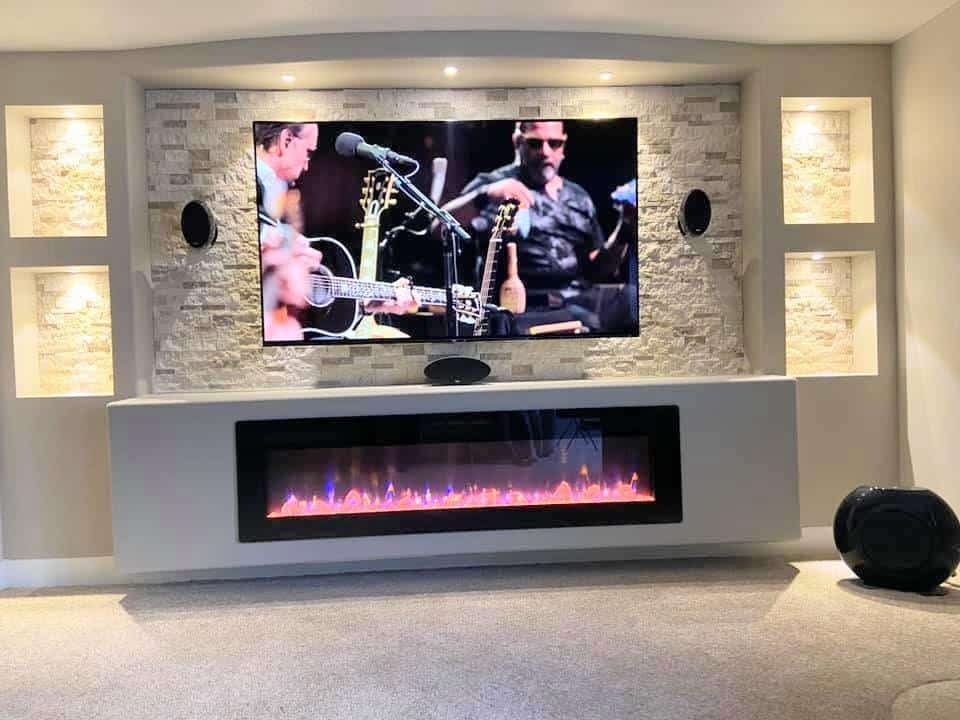
Transforming your basement into the ultimate man cave means setting up a dynamic home theater that goes beyond a TV. It involves choosing the right audio systems, lighting, and media players to cater to all entertainment preferences — from sports to classic vinyl records. Strive to create a functional centerpiece that reflects your style.
Focus on getting a high-resolution projector that matches the room's size and has a suitable brightness for clarity. Consider both fixed-frame and retractable screens for flexibility, and invest in a quality surround sound system that includes a receiver, multiple speakers, and a subwoofer to bring movies to life.
Organize and display your movie collection using shelving or custom cabinets, showcasing special editions and memorabilia in display cases. Digitizing your collection also makes it easily accessible while preserving physical copies.
Ensure comfort with varied seating options like sectional sofas for flexibility, recliners with cup holders, or casual bean bags. Arrange your furniture so everyone has an unobstructed view of the screen and easy access to snacks and drinks.
By carefully selecting equipment, organizing your media, and providing comfortable seating, your man cave will become a personalized retreat for relaxation and entertainment, ensuring every movie night is an enjoyable experience.
Every man cave should reflect the unique personality and interests of its owner. Adding personal touches and integrating your hobbies into the design creates a dedicated space that genuinely feels like your own. Consider hanging your guitars on the wall, setting up a model building station, or displaying your collection of vintage comics.
The idea is to make your man cave more than a room; make it an extension of yourself. The small details — a beer cap collection, travel souvenirs, or even your hand-painted miniatures — change an ordinary room into your custom man cave with personal significance.
For sports enthusiasts, there's no better way to express allegiance than by dedicating a portion of your man cave to your beloved teams. Displaying sports memorabilia is a perfect way to pay homage and bring some competitive spirit into your space.
| Type of Memorabilia | Description |
| Jerseys | Frame and mount signed or vintage jerseys |
| Trophies | Display personal sports achievements or replicas of famous trophies |
| Signed Goods | Showcase signed balls, bats, or photographs |
| Pennants & Banners | Hang your team's colors proudly |
Use lighting to highlight your most prized possessions, and consider creating a feature wall dedicated to your team's greatest moments. Sports memorabilia is definitely a conversation starter but also adds color and a personal narrative to your ultimate man cave.
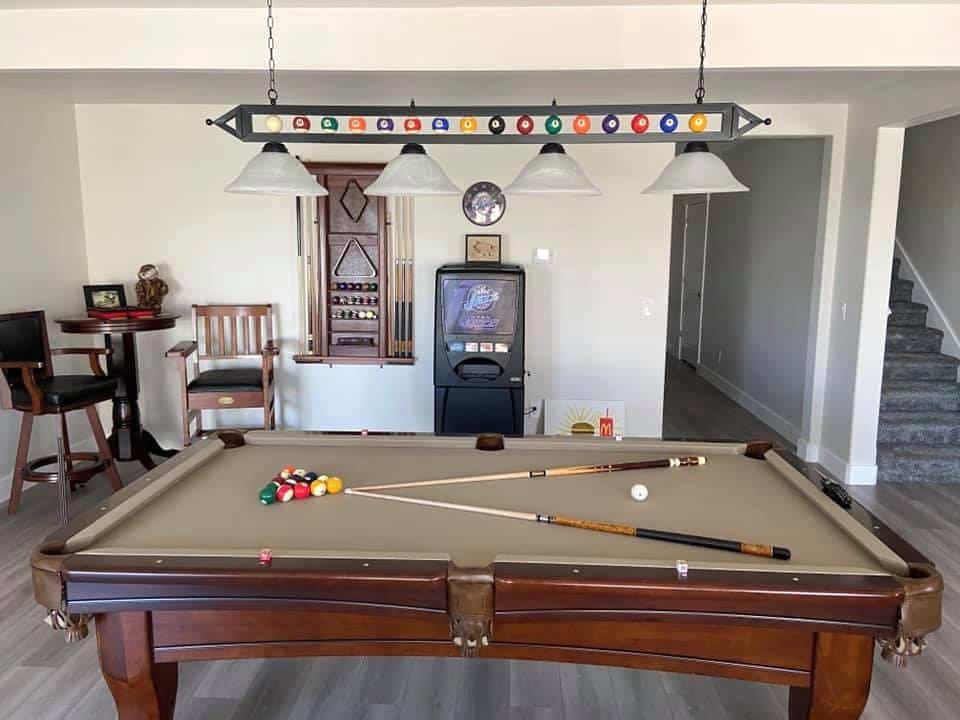
No perfect man cave is complete without a fun and interactive element like a pool table or game table. A symbol of the ideal space to unwind, these gaming tables offer endless hours of entertainment and game nights with friends.
When choosing a pool table or another game table for your man cave, several important factors must be considered to ensure the best fit and enjoyment. First, assess the size of the table in relation to the available space in the room; it should be large enough to enjoy but not so large that it overwhelms the space.
Next, evaluate the quality of the materials used in the table's construction, which will affect its durability and longevity. Additionally, select a style that harmonizes with the overall aesthetic of your man cave, enhancing its theme and ambiance.
For those looking to maximize versatility, consider a multipurpose game table that can switch between foosball, ping pong, and air hockey. This allows for varied entertainment options without requiring additional space for multiple tables.
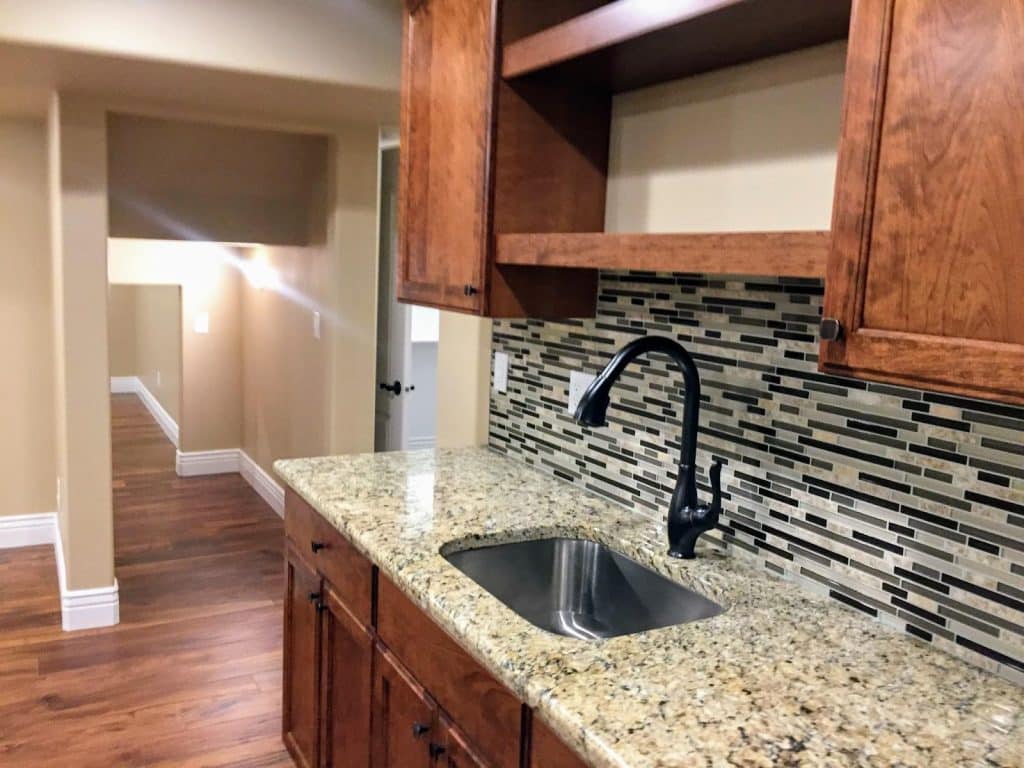
One of the hallmarks of the dream man cave is a well-stocked and accessible bar area. Whether you're into craft beers, fine wines, or cocktails, a bar unit equipped with a mini-fridge will keep your beverages chilled and ready for any occasion.
Consider including the following for a functional bar area:
| Bar Must-Haves | Purpose |
| Mini-fridge | Keeps refreshments cool |
| Bar stools | Comfortable seating for guests |
| Glassware | Appropriate for different types of drinks |
| Shelves | Store spirits and decorative items |
Add personal flair with neon signs, custom coasters, or even a popcorn machine for that authentic bar vibe. This space should cater to your taste buds but also function as a social hub during gatherings. By incorporating these amenities and proper ventilation to keep the area fresh, your basement man cave becomes the go-to place for a great time.
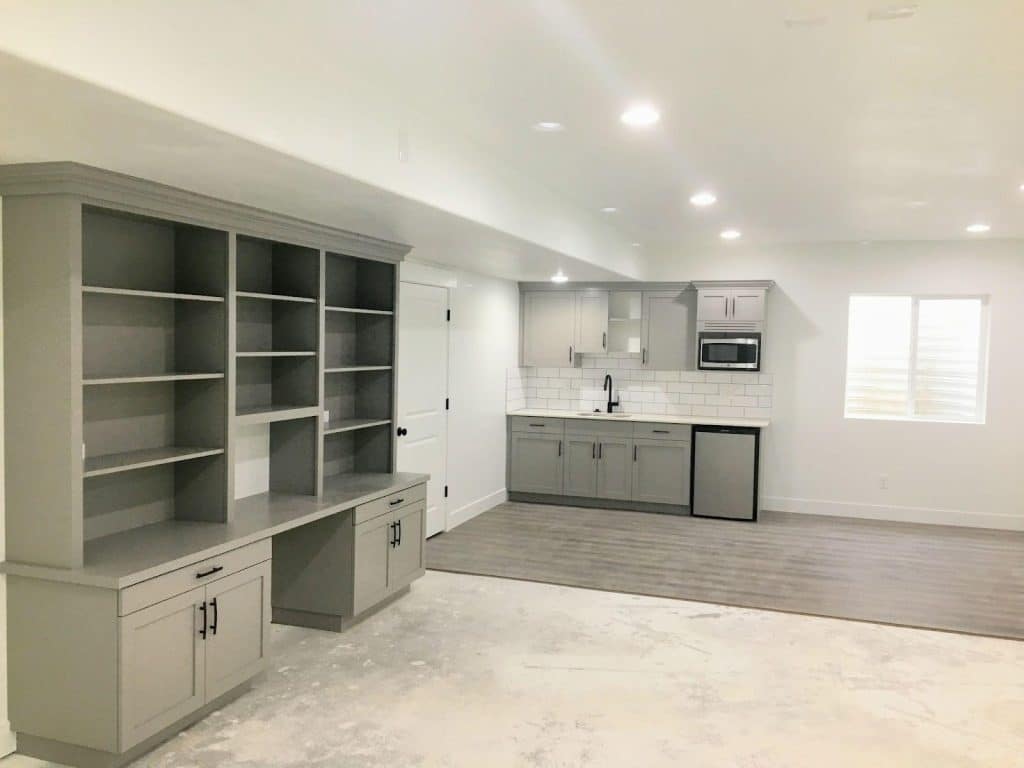
Keep your man cave tidy with strategic storage solutions. Built-in cabinets can enhance the decor of a finished basement, while freestanding units offer flexibility in an unfinished space. Utilize cabinets to hide electronics, shelving units for books, closet organizers for wardrobe management, and furniture with hidden compartments for additional space.
Manage cables with zip ties, Velcro straps, or cable management boxes to maintain a sleek look. Install raceways or cord covers to keep wires neatly aligned,, and consider wireless devices to minimize clutter.
Boost the utility of your basement man cave by adding a home office or workout area. Equip the office with a sturdy desk, ergonomic chair, and adequate lighting, and create a workout zone with space for gym essentials like a yoga mat, free weights, and wall-mounted racks. These additions make your space a place for leisure, productivity, and health.
By efficiently organizing and using multifunctional spaces, your basement man cave becomes a personalized retreat that's both impressive and practical, perfect for relaxation, entertainment, and more.
Whether you're installing a state-of-the-art home theater, organizing a gaming paradise, or simply creating a comfortable retreat, the success of your project depends greatly on the expertise and dedication of the team you choose to bring your vision to life. CCS of Utah is ideally suited to assist you every step of the way.
Our commitment to quality craftsmanship and personalized service ensures that every aspect of your man cave — from construction and design to the final touches — is handled with care and precision. Trust CCS of Utah to turn your basement into a space that perfectly suits your leisure and style needs, making every moment spent there truly special.
Contact CCS of Utah for a free quote, and let us help you create a personal sanctuary that you'll enjoy for years to come.
Welcome to the ultimate guide for transforming your basement into the cozy, personal movie theater of your dreams! Imagine the joy of snuggling into your favorite chair, surrounded by loved ones, with the lights dimmed, ready to dive into another world right in the comfort of your own home.
Our journey today aims to peel back the curtain on the essential items you absolutely need to bring this vision to life. We're diving deep into the heart of what makes a home theater truly magical. From the soft embrace of the perfect seating to the immersive allure of crystal-clear sound, each piece plays a pivotal role in crafting your cinema sanctuary.
So, let's embark on this exciting adventure together. With a sprinkle of creativity, a dash of passion, and the right insights, we'll help you create a basement theater that's a feast for the eyes and a haven for the soul.
When crafting the perfect basement theater, the seating you choose becomes the cornerstone of your cinematic sanctuary. Think of your seats as thrones, where every movie becomes a royal experience, enveloped in comfort and style. The right seating creates an immersive environment that beckons you to unwind and dive into the storytelling on screen.
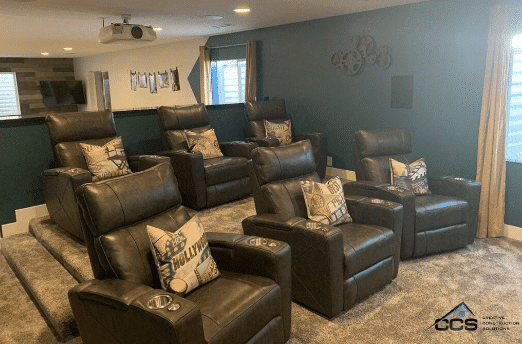
Plush, comfortable seating is non-negotiable for achieving this delicate balance. It enhances the overall viewing experience, making long movie marathons or back-to-back episodes feel like a luxurious escape rather than a cramped inconvenience.
The beauty of designing your basement theater is the freedom to tailor it to your unique preferences and spatial constraints. Whether your heart is set on replicating a traditional cinema feel or you're crafting a cozy nook for family movie nights, there's a seating option out there for you.
For those seeking the ultimate in individual comfort, look no further than a set of plush recliners. Many models have built-in cup holders and USB ports, ensuring your beverages stay secure and your devices are charged throughout the show.
Arrange them in rows with aisle lighting for a true theater experience, or semi-circle them for a more intimate setting.
Ideal for family gatherings or movie nights with friends, sectional sofas offer versatile and spacious seating. They invite everyone to kick back, relax, and snuggle under a blanket. With the vast array of configurations available, you will easily find one that fits your space and ensures no one has to strain their neck or miss out on the action.
For a laid-back vibe or if you're working with a tighter budget, bean bags are a fun and flexible alternative. They add a splash of color and whimsy to your home theater, and they're perfect for kids or the young at heart.
Easily moved and stored, bean bags allow you to switch up your seating arrangement based on the crowd or occasion.
In your quest for the perfect basement theater, never underestimate the power of comfortable seating to elevate your movie-watching experience and create an event that feels special every single time. Choose wisely, and your basement theater will quickly become everyone's favorite room in the house.
The screen in your basement theater is your window into the vast universes of cinema. It's more than a display — it's where stories come to life, emotions are felt, and memories are made. Choosing between a high-quality projector or a large-screen TV sets the tone for your cinematic journey.
Projectors offer an unrivaled cinematic experience, bringing the grandeur of movie theaters into your home. They excel in creating larger-than-life images, which are essential for capturing each scene's full scope and detail. Imagine the thrill of watching epic landscapes and action sequences on a screen that stretches from floor to ceiling, fully immersing you in the movie's world.
Projectors shine in their ability to adapt to various screen sizes, accommodating your space and viewing preferences. They're perfect for rooms where the theater feel is paramount, offering flexibility in setup and placement. There's something undeniably magical about the lights dimming and the projector flickering to life, replicating the authentic theater ambiance.
A large-screen TV is a compelling choice for those prioritizing sharpness, color accuracy, and hassle-free setup. Today's models boast incredible resolution, vibrant colors, and stunning contrast, ensuring every frame is a feast for the eyes.
Unlike projectors, TVs are ready to dazzle without the need for darkness. Their brightness and clarity stand up to ambient light, making them versatile for various lighting conditions.
A large-screen TV might be a more practical option for smaller spaces or for those seeking a straightforward, low-maintenance setup. It integrates seamlessly into your living environment, offering entertainment and aesthetic appeal even when off.
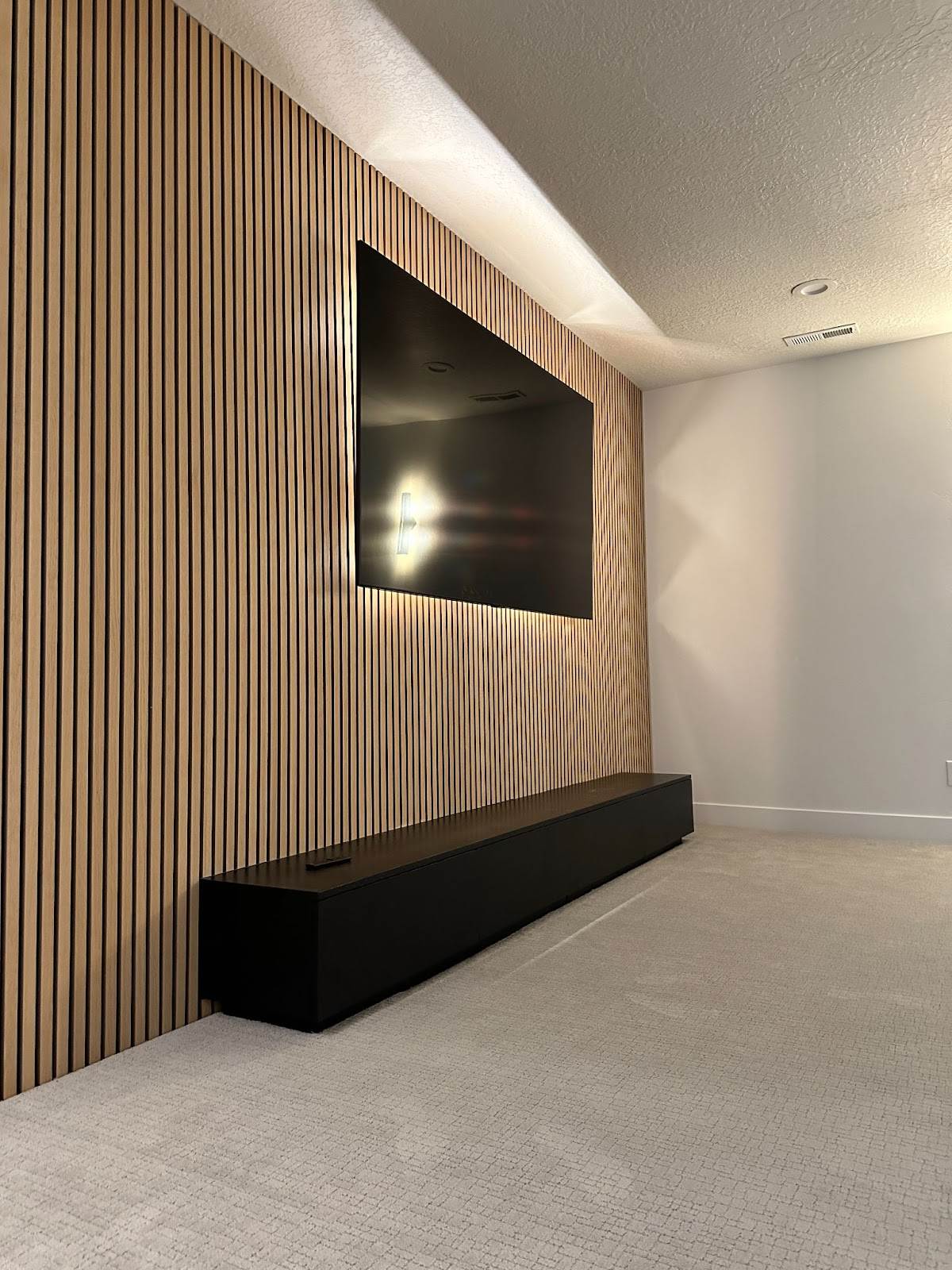
Choosing between a projector and a large-screen TV boils down to personal preference and the specific requirements of your space. Consider the following:
Whether you choose the expansive canvas of a projector or the sharp, vibrant display of a large-screen TV, ensure it resonates with your vision of the perfect home theater experience.
With its rich layers of audio, a sound system transforms a simple movie night into a thrilling adventure, making you feel every heartbeat, gust of wind, or whisper with crystal clarity. Surround sound capabilities are essential ingredients that elevate the movie-watching experience and immerse you in soundscapes that make every scene more vivid and real.
Surround sound systems achieve an immersive audio experience by strategically placing speakers around the room to create a multi-dimensional soundscape. Selecting the right components for your sound system is crucial for achieving enveloping audio that breathes life into every film.
Soundbars are a fantastic option for those seeking simplicity without sacrificing quality. Modern soundbars simulate a surround sound experience through cleverly designed speaker arrays and acoustic reflection. They're perfect for tighter spaces or for anyone looking to streamline their setup without clutter.
Speakers are the heart of any true surround sound system. A traditional setup includes front, center, rear, and sometimes even ceiling-mounted speakers to create a bubble of sound. Mixing and matching speakers allows you to customize the audio environment to your room's acoustics and your personal preferences.
For the ultimate experience, consider adding a subwoofer to handle the lows, providing that rumble during intense action scenes or depth in musical scores.
Think of the receiver as the conductor of your audio orchestra, tying together your speakers, soundbar, and other audio sources. It processes the audio signal, distributes it across your speakers, and ensures that the sound quality remains pristine at every volume level.
A good receiver is the backbone of any sophisticated sound system, allowing for future upgrades and ensuring compatibility with various audio formats.
When assembling your sound system, consider the size and shape of your basement theater. Smaller rooms might benefit more from a high-quality soundbar, while larger spaces truly shine with a comprehensive set of speakers and a powerful receiver. Remember, the goal is to create an environment where the audio makes every viewing an experience to remember.
Tailor your system to match your viewing habits and space. Whether it's the subtle dialogues in a drama, the intricate soundscapes of a nature documentary, or the explosive action of a blockbuster, a superior sound system ensures you catch every nuance. It's about bringing movies to life, creating an auditory experience that complements the visual, and transforming your perfect basement theater into a gateway to worlds unseen and untold.
Lighting does more than illuminate; it transforms, creates ambiance, and sets the stage for every scene in your cinematic journey. In your basement theater, lighting becomes a dynamic player in the movie-watching experience, capable of enhancing emotions, building suspense, and gently guiding your focus.
The heart of atmospheric lighting lies in its ability to adapt, to ebb and flow with the rhythm of the film. Dimmable LED lights are your best allies here. They offer unparalleled control over brightness and tone. Use LEDs to fine-tune the lighting to match the mood of the movie, from the eerie glow for a suspense thriller to a soft, warm hue that enhances the colors of a romantic comedy.
While artificial lighting sets the mood, controlling natural light ensures it remains consistent. Nothing breaks the spell of a captivating film like a glare across the screen or the distracting shift of sunlight creeping into the room. Blackout curtains or shades are essential tools in your lighting arsenal, offering a simple yet effective way to block out unwanted light.
With the right window treatments, you will maintain the perfect viewing environment at any time of day, ensuring that your cinematic escape is always ready when you are.
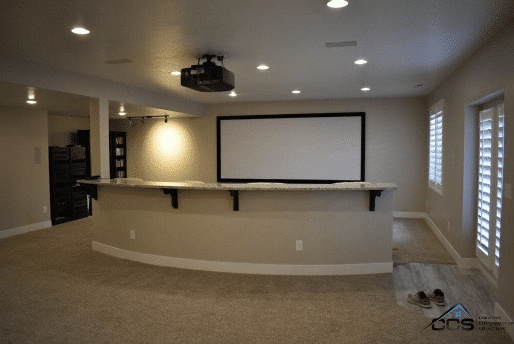
CCS of Utah excels in transforming basements into dream theaters, seamlessly integrating design, technology, and personalized service. From conception to completion, we ensure a hassle-free process, avoiding the need for multiple subcontractors and guaranteeing a cohesive, high-quality outcome.
CCS of Utah is committed to realizing your vision, whether it's a cozy retreat or a cutting-edge cinema. Contact CCS of Utah today to schedule an estimate.
Imagine stepping into a cozy nook in your home where the aroma of fresh coffee blends with the sizzle of a morning omelet. That's the allure of a kitchenette, a compact culinary haven within your living space.
This scaled-down cooking space redefines efficiency. With the right equipment, appliances, and storage space, a kitchenette becomes a valuable addition to your home.
Delving into the concept of a kitchenette, let's explore its functionality, design, and potential to transform your living experience.
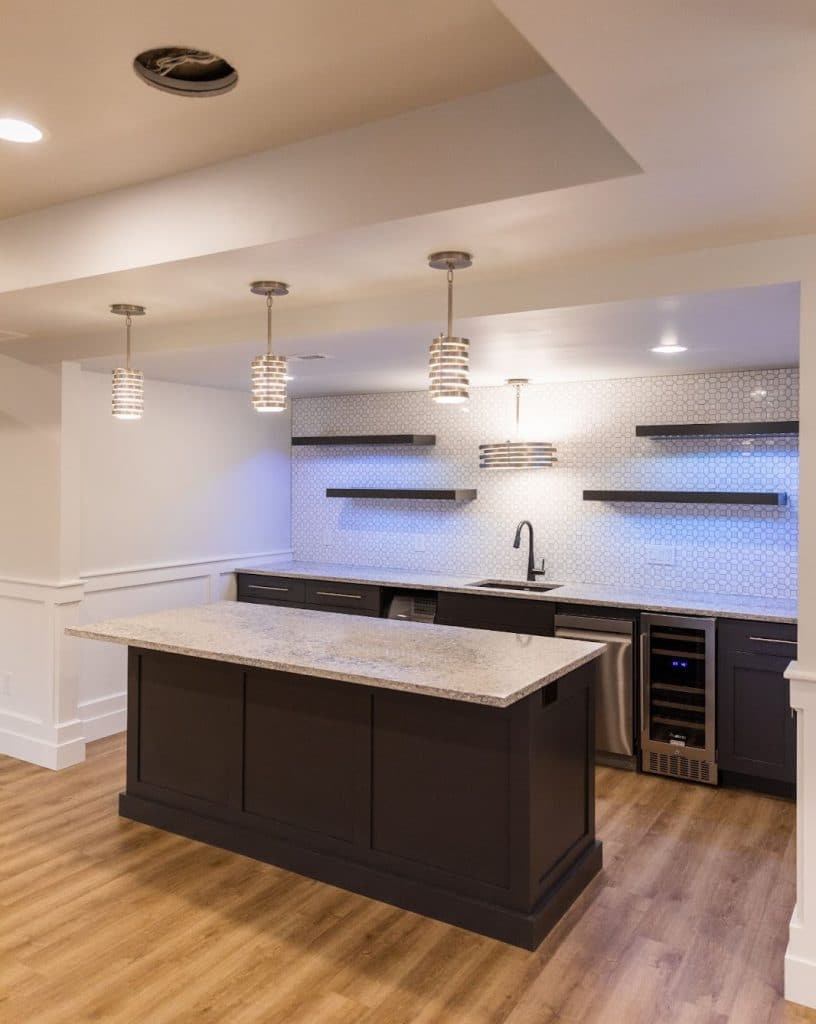
A kitchenette is a compact version of a full-size kitchen, streamlined for convenience and space efficiency. It typically comes equipped with the features of a full-sized kitchen, but smaller. This scaled-down culinary station is an attractive option for areas that cannot accommodate a full kitchen setup due to size or budget constraints.
Despite its modest dimensions, the kitchenette skillfully delivers functionality, making it an ideal choice for studio apartments, offices, basement conversion projects, or as an additional hospitality feature in a guest room. It offers a practical solution for basic meal preparation and storage within a confined footprint.
A kitchenette consolidates the core functions of a kitchen into a compact, streamlined package. It houses appliances scaled to fit its reduced size, like mini-fridges, mini freezers, and compact ovens, alongside necessary kitchenware and storage options.
Another popular kitchenette feature is a kitchenette bar, stocked with your favorite drinks and treats. Kitchenette bars are a great addition because they provide a useful service in a compact area. A kitchenette may not be the best place to cook a big Thanksgiving meal, but a kitchenette bar is perfect for socializing with low-effort snacks and beverages.
A kitchenette includes the amenities for simple meal preparation in a few square feet. With the right appliances and layout, a kitchenette is nearly as functional as a full-sized kitchen.
Full kitchens provide ample storage and support a broad range of cooking activities. In contrast, designers create kitchenettes to provide essential capabilities in a compact and often portable format, focusing on the most fundamental aspects of meal preparation. While full kitchens are central to home life, kitchenettes provide supplementary service in spaces where a traditional kitchen wouldn't be feasible.
Full kitchens typically span a larger area — with space for extensive countertops, multiple appliances, and often an area for dining. Meanwhile, kitchenettes concentrate on the basics: a place to prepare food and a means to store it. These facilities prioritize efficiency over expansiveness.
Kitchenettes are less difficult to install, maintain, and use than full kitchens. The reduction in scale makes it easier to include in a home or business. With the rise of micro-living and streamlined lifestyles catering to a minimalist sensibility, kitchenettes have gained popularity in creating functional culinary spaces in non-traditional settings.
Setting up a kitchenette within your home redefines functional flexibility. Imagine the ease of preparing a beverage or snack without traversing to the main kitchen — this is particularly beneficial in multi-story homes or when hosting guests. This level of convenience suggests luxury but fundamentally connects to your living space's practicality. Moreover, having a secondary kitchen area reduces traffic and usage in your primary culinary zone.
Investing in a kitchenette is a strategic financial decision. Not only does it enhance the appeal of your home, but it also translates into tangible value increases. Kitchenettes often entice prospective buyers or renters should you enter the real estate market.
Introducing a kitchenette within your dwelling opens up the opportunity for rental scenarios. For homeowners considering a supplementary income stream, creating a self-contained area with a kitchenette facilitates short-term rentals or accommodates extended family with comfort and independence. It’s a transformation that enables your home to adapt to dynamic living arrangements, and the potential for financial gain is real and achievable.
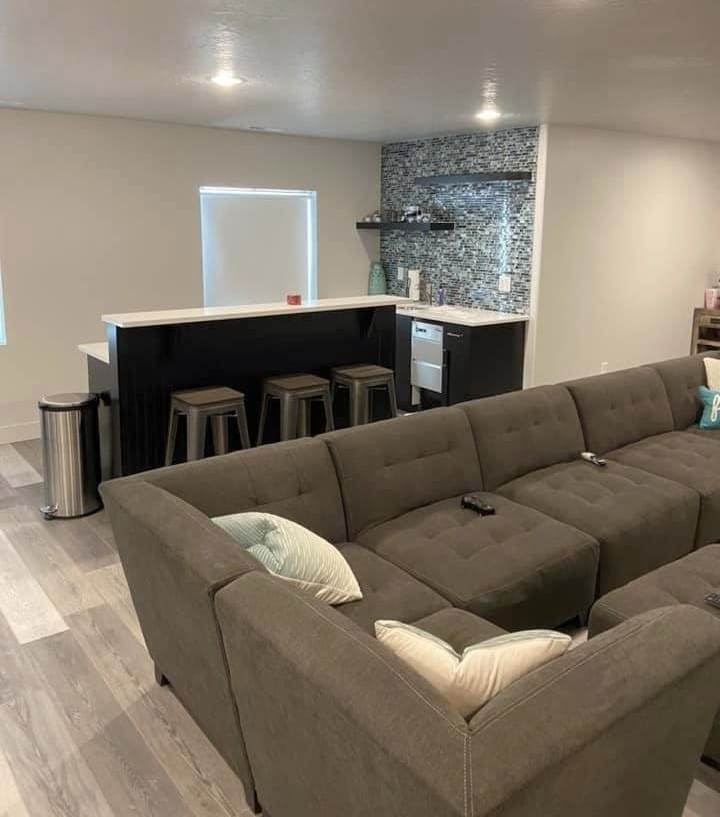
A well-equipped kitchenette dramatically enhances your entertainment capacity for hosting gatherings and entertaining guests.
One of the key advantages of having a kitchenette in your home is the ability to prepare food and beverages without relying on a larger kitchen space. This is especially beneficial when hosting parties or events where you need to serve a large number of guests and need more than one food prep area.
In addition to food preparation, a kitchenette provides a designated space for storing and displaying drinks and snacks. For instance, consider installing a mini-fridge or a beverage cooler to keep your drinks chilled and easily accessible. This eliminates the need for guests to constantly go back and forth to the main kitchen, allowing them to enjoy the party without interruptions.
Furthermore, you have the option to equip a kitchenette with essential appliances such as a microwave, toaster oven, or even a small dishwasher. These appliances make it convenient to heat up or cook small meals, making your kitchenette a versatile space for quick and easy food preparation.
Another advantage of having a kitchenette is its added convenience during extended gatherings or overnight guests. With a kitchenette, your guests have access to basic amenities such as a coffee maker, sink, and countertop space, allowing them to make breakfast or snacks without disturbing the rest of the household.
Overall, a well-designed kitchenette significantly enhances your entertainment capacity by providing a dedicated space for food preparation, storage, and convenience. Whether hosting a small gathering or a large party, having a kitchenette ensures you cater to your guests' needs without hassle. If you are considering remodeling your home, incorporating a kitchenette into your design is a valuable addition that will elevate your entertainment experience.
Basement spaces often provide the ideal canvas for a kitchenette, offering seclusion and sufficient square footage. Here, privacy pairs up with the practicality of an additional food prep area.
Basement in-law suites grant family closeness without sacrificing autonomy, especially with a kitchenette feature.
Upper-level living spaces, such as converted attics or bonus rooms above garages, present optimal kitchenette settings. With kitchenettes, these areas transform into self-sufficient studios or guest lodgings, embracing comfort and functionality.
Consider the strategic placement of a kitchenette in your primary suite for a touch of luxury. It provides convenience for morning coffee rituals or late-night snacks and serves as a private bar during social gatherings.
When outfitting your kitchenette, opt for streamlined appliances and fixtures that reflect a commitment to functionality and design harmony. Efficiency is your guiding principle. Look for choices like under-counter refrigerators, single-basin sinks, and a compact dishwasher or dishwasher drawer. Utilize finishes and materials that are attractive, durable, and easy to maintain to ensure your kitchenette withstands the test of time.
When choosing cabinetry and countertops, consider their spatial impact and storage potential. Opt for cabinets with built-in organizers, for example, or install a counter with a pull-out cutting board. Every inch in a kitchenette is precious; your attention to detail in these elements profoundly affects the space’s overall functionality and visual appeal.
When outfitting a compact area like a kitchenette, appliance selection is crucial. Seek out units specifically designed for small spaces that offer full functionality without dominating the room. These are often termed as “compact” or “space-saving” appliances. You can find them in a variety of styles and performance levels to meet your exact needs.
Your primary focus should be selecting appliances that meld multifunctionality with a small footprint — such as a microwave-convection oven combo, a compact refrigerator, and a small cooktop. These perform the necessary tasks while taking up minimal space, making them ideal for a kitchenette.
In addition to functionality and size, consider the aesthetics. Appliances should integrate seamlessly with the kitchenette's decor. Options now cater to a variety of styles, from modern stainless steel to retro-inspired designs, so you will find something to align with your personal taste and design vision.
Moreover, consider energy efficiency to balance functionality with sustainable practice.
Lastly, advancements in appliance technology have made leaps in space efficiency and user-friendliness. Invest in the latest innovations — a key example is the new under-counter refrigerator drawers or induction cooktops that effectively use space and a smooth, sleek appearance. Smart appliances also offer enhanced features within compact designs, adding convenience and a touch of modernity to your kitchenette's functionality.
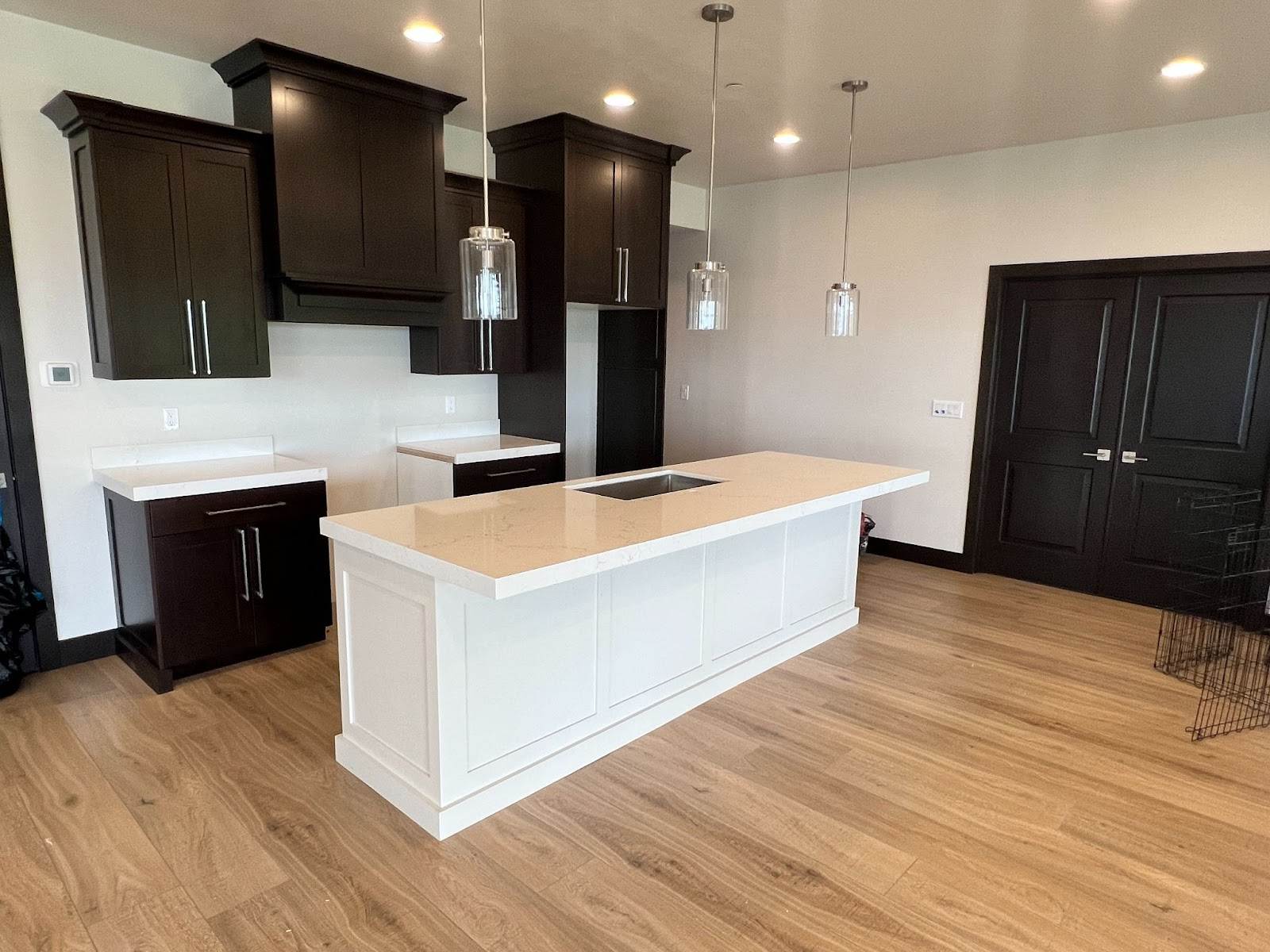
Elevate your home's functionality with a tailored kitchenette designed by Creative Construction Solutions. Our expertise ensures an elegant, space-saving installation that defines efficiency and style.
Conceiving a kitchenette need not be daunting or complex with our seasoned professionals at the helm. We scrutinize every detail of your space, integrating innovative solutions that maximize utility while keeping the aesthetic seamless and aligned with your home's decor.
Partner with us to embark on this transformative journey. Leveraging our comprehensive services, from design conceptualization to execution, we guarantee a remodel that meets and surpasses your expectations.So why wait? Contact Creative Construction Solutions today!
Basement renovation is an exciting prospect. Basement finishing and renovation turn an often-underused area of your home into a vibrant living space, be it a cozy family room, an elegant entertainment area, or a practical home office. However, the success of such a transformation largely depends on the expertise and reliability of the basement finishing contractor you choose.
Your contractor will have a hand in every part of the basement renovation process, so selecting the right one is vital. You want to find a professional who can bring your vision to life while ensuring your home's structural integrity and safety. The right contractor will understand your aesthetic preferences and navigate the unique challenges of basement renovations, such as moisture control, lighting, and ventilation.
In this blog, we’ll guide you through the key factors to consider when selecting a basement finishing contractor. From verifying credentials to understanding their communication style, we'll cover what you need to know to make an informed decision and ensure a successful renovation project.
Your contractor’s experience and specialization are paramount when embarking on a basement finishing project. A contractor with a specific focus on basement renovations brings a wealth of knowledge essential for navigating the unique challenges of basement projects. Basements require special attention to aspects like moisture control, insulation, and lighting. An experienced basement finishing contractor will deeply understand these elements and know how to address them effectively.
The quality of your finished basement heavily relies on this specialized knowledge. A contractor well-versed in basement projects will be able to recommend the best materials and methods that will lead to a beautiful, functional, and durable result. They can provide insights into the latest trends and technologies in finished basements, helping you make choices that add value to your home.
When interviewing potential contractors, look into their experience with basement projects. Ask about the number of basement renovations they have completed and request to see a portfolio of their work. Inquire about any challenges they have encountered in previous projects and how they overcame them. This will give you a clearer picture of their expertise and problem-solving abilities.
Additionally, ask for references from past clients who had similar projects. Speaking directly with these clients provides valuable insights into the contractor's work ethic, reliability, and overall satisfaction with the completed project. It's also a good idea to ask about the contractor's experience obtaining permits and adhering to local building codes, as this is a critical aspect of any basement renovation.
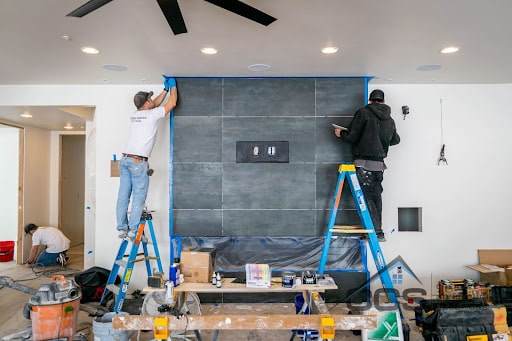
Choose a licensed and insured contractor for your basement finishing project. Licensing ensures that the contractor has met certain industry standards and qualifications, while insurance protects against potential accidents or damage during the renovation process. Working with a contractor who lacks these credentials exposes you to certain risks and liabilities.
Licensed contractors have demonstrated their knowledge and adherence to building codes and regulations. This is particularly important in basement renovations, where you may encounter issues with proper egress, electrical wiring, and plumbing. An unlicensed contractor may not be aware of these regulations, leading to subpar and potentially hazardous work. Furthermore, if the work does not meet local building codes, you may face difficulties when selling your home or even be required to redo the work at additional cost.
Insurance coverage is equally important. It protects you from being held liable for accidents or injuries on your property during the renovation. Without this protection, you could be responsible for medical bills or legal fees. Insurance also covers damage to your property caused by the contractor, so you are not left to bear the cost of repairs alone if something goes wrong.
To verify a contractor's licensing and insurance, ask for their license number and insurance details. You can then check the validity of their license with your local licensing board and confirm their insurance coverage by contacting the insurance provider. This verification process will tell you if your contractor is qualified, reputable, and operating within the legal requirements of your area.
Getting a successfully finished basement hinges on a detailed project plan and a clear estimate. These documents serve as the blueprint and financial guide for your renovation, outlining every aspect of the project from start to finish.
A well-defined plan sets clear expectations and helps prevent misunderstandings and disputes, contributing to your project's smooth and successful completion. The importance of a detailed project plan cannot be overstated.
This plan should comprehensively cover all project phases, including design, construction, materials, and timelines. It acts as a roadmap, guiding you and the contractor through each renovation step. It helps track progress, manage resources, and align every detail with your vision. A clear and thorough plan also allows for better communication, as it provides a reference point for discussions and decisions throughout the project.
Similarly, a clear estimate is crucial for understanding the financial aspects of your basement renovation. It should provide an itemized breakdown of all costs, including materials, labor, and additional expenses. This cost transparency helps you budget effectively and avoid unexpected expenses. It also allows you to compare estimates from different contractors and make informed decisions.
When reviewing a project plan and estimate, look for specificity and detail. The plan should include a timeline with milestones and completion dates for different project stages. It should also specify the types and quality of materials and any subcontractors. The estimate should be detailed enough to give you a clear understanding of what the price includes and what counts as extra cost.
In the quest to find the ideal basement finishing contractor, look into references and reviews. These firsthand accounts from past clients are invaluable in painting a realistic picture of what to expect from a contractor. They offer insights into the contractor's reliability, quality of work, and ability to deliver on promises.
Contractors will typically provide references. These are a direct line to previous clients willing to share their experiences. Engaging with these references allows you to ask specific questions about the contractor's work ethic, adherence to timelines, communication style, and response to any challenges during their project. This conversation can reveal a lot about the contractor's professionalism and the satisfaction level of their clients.
Reading online reviews is another way to assess a contractor. These reviews often provide a broader range of perspectives, covering various aspects of the contractor's work across multiple projects. Look for patterns in the reviews — consistent comments about excellent craftsmanship or strong communication skills indicate a contractor's strengths. Conversely, repeated mentions of the same issues, such as delays or budget overruns, are red flags.
When assessing references and reviews, approach them with a critical eye. Consider the context of each review and the specific details provided. A single negative review amidst a sea of positive ones may not be a cause for concern, but multiple negative reviews highlighting the same issues should warrant further investigation.
Additionally, pay attention to how the contractor responds to reviews, particularly negative ones. A professional and constructive response to criticism is a sign of a contractor's commitment to customer satisfaction and continuous improvement.
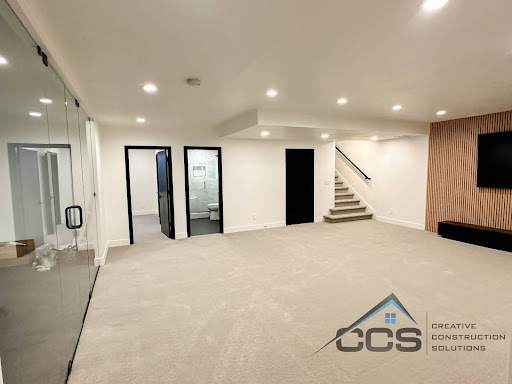
Good communication and exceptional customer service are important for any renovation. These elements are the lifeblood of a successful project, influencing the result and your overall experience during the renovation process. A contractor who excels in communication and customer service brings clarity, trust, and ease to what can otherwise be a complex and stressful endeavor.
Effective communication ensures that your vision for your finished basement comes to fruition. It involves more than exchanging information; it's about establishing a clear understanding between you and the contractor. This mutual understanding helps you and your contractor align expectations, make informed decisions, and address any concerns or changes.
To assess a contractor's communication style and responsiveness, pay attention to your interactions from the very first contact. Notice how quickly they respond to your inquiries and how thoroughly they answer your questions. During initial meetings, observe if they listen attentively to your ideas and provide clear, jargon-free explanations. A contractor who takes the time to understand your needs and preferences and communicates in a way that makes you feel informed and comfortable will likely maintain this level of engagement throughout the project.
Additionally, consider the contractor's approach to customer service. Do they show a genuine interest in your project? Are they accommodating and flexible in addressing your concerns? A contractor who prioritizes customer satisfaction and goes the extra mile is invaluable in a basement finishing project.
Selecting the right basement finishing contractor is a decision that requires careful consideration. If you’re looking for expert guidance and quality craftsmanship, consider Creative Construction Solutions for your basement renovation. Our team of experienced professionals is here to bring your vision to life with the utmost attention to detail and customer satisfaction.
Contact Creative Construction Solutions to learn more about our services and to schedule a consultation. Let us help you create the basement of your dreams.
Transforming a basement into a functional and inviting space has become a popular trend in home improvement. Among the various upgrades one can make, adding a kitchenette is particularly appealing. A basement kitchenette is a compact, yet fully functional kitchen area, meticulously designed to combine convenience with style.
This small-scale kitchen solution is ideal for those who enjoy hosting gatherings and entertaining guests, as it allows for easy preparation of snacks and beverages. Additionally, it is a practical amenity for individuals who spend considerable time in their basement, whether for leisure activities, work, or a creative studio. By incorporating a kitchenette, the basement transforms into a more versatile and self-sufficient space, enhancing the overall functionality and comfort of the home.
The trend of adding kitchenettes to basements has gained momentum in recent years. Homeowners are seeing the immense value in utilizing every square foot of their homes, and the basement is no exception. A well-designed kitchenette can significantly enhance the functionality of your basement, whether it's a family room, home theater, or guest suite.
In this blog, we'll guide you through the essential features that make a basement kitchenette functional and stylish. From space-saving designs to the right choice of appliances, we'll cover everything you need to know to create a kitchenette that's not only practical but also a delightful addition to your home.
In basement kitchenettes, space is a premium commodity. That's why an efficient layout and design are paramount in making the most of the limited area. A well-thought-out layout maximizes functionality and enhances the overall aesthetic appeal of your space. Try to balance practicality and style so every inch serves a purpose without sacrificing your desired look and feel.
Efficient layout and design in a basement kitchenette are about making intelligent use of space. It's about creating a blend of functionality and style, where every element is carefully chosen to create a space that's practical and a joy to be in.
First and foremost, consider the workflow. A kitchenette, though small, should still follow the classic work triangle principle — easy access between the sink, refrigerator, and cooking area. This setup minimizes unnecessary movement, making your kitchenette more efficient and enjoyable to use.
When it comes to design ideas, think smart and stylish. Opt for sleek, compact units that offer storage without overwhelming the space. Wall-mounted or floating cabinets are excellent choices as they free up floor space while providing ample storage. Similarly, consider a fold-down table or a pull-out countertop that can serve as a dining area or extra prep space when needed and then be neatly tucked away.
Utilizing vertical space is another key strategy. Install shelves up to the ceiling to store less frequently used items, and use hooks or magnetic strips to hang utensils, pots, and pans. This saves precious counter space and adds a touch of personality to your kitchenette. Using vertical space for storage also makes your kitchenette look bigger.
Choosing multipurpose furniture is a game-changer in a basement kitchenette. For instance, a small island on wheels can serve as a prep station, dining area, and storage unit all in one. Look for versatile pieces that can adapt to different needs — perhaps a sofa that doubles as storage or an adjustable bar stool that fits different counter heights.
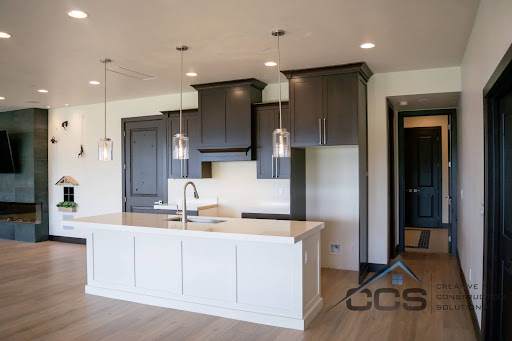
The heart of any kitchenette lies in its appliances, and when it comes to a basement kitchenette, compact appliances are a necessity.
These smaller versions of standard appliances are designed to fit into limited spaces without compromising functionality. They are the key to maintaining the efficiency of your kitchenette while ensuring it remains as functional as a full-size kitchen. Look for energy-efficient models with the same features as their larger counterparts, just in a smaller package.
The first thing to consider when selecting appliances for your basement kitchenette is the size. Mini-fridges are perfect for storing beverages and small food items, making them ideal for a basement entertainment area or guest suite. Look for models with a separate freezer compartment to give you a bit more versatility in what you can store.
Compact dishwashers are another great addition. They typically come in 18-inch sizes, much smaller than the standard 24-inch, yet are surprisingly spacious inside. A compact dishwasher means you won’t have to carry dishes upstairs to clean them, adding convenience and functionality to your space.
Convection microwaves are a fantastic multipurpose option. They combine the quick convenience of a microwave with the baking and roasting capabilities of a conventional oven. This means you can heat up snacks, bake a small batch of cookies, or even roast a chicken right in your basement kitchenette. It's a space-saving wonder that covers most of your cooking needs.
Choosing the right compact appliances for your basement kitchenette is about understanding your space and needs. By selecting the right appliances for your needs, you make your kitchenette as functional as it is stylish — a destination in itself.
For a basement kitchenette, the materials for countertops and flooring should be practical and durable. In a space that's often the hub of activity, surfaces need to withstand frequent use and be easy to clean so your kitchenette remains both functional and beautiful over time.
For countertops, materials like quartz, granite, or solid surface composites are excellent choices.
Quartz is particularly popular due to its non-porous nature, making it stain-resistant and low-maintenance.
Granite, while requiring a bit more upkeep, offers a unique, natural look and is incredibly durable.
Solid surface composites are available in a variety of colors and patterns and are easy to repair if scratched or damaged.
Flooring in a basement kitchenette must be stylish and capable of withstanding moisture and heavy foot traffic. Vinyl flooring, especially luxury vinyl tile (LVT) or planks (LVP), is a great option. It's water-resistant, comfortable underfoot, and comes in a range of designs that can mimic the look of wood or stone.
Ceramic or porcelain tiles are also great options due to their durability and ease of cleaning, though they may require more maintenance with grout lines.
Maintaining these surfaces will keep your kitchenette looking its best. For countertops, a daily wipe-down with a mild cleaner or a damp cloth is usually sufficient to keep them clean and hygienic. For flooring, regular sweeping or vacuuming, followed by mopping with a suitable cleanser, will keep it looking fresh and new.
It’s good to have a quick cleaning routing for a small space like a basement kitchenette. Keep cleaning supplies handy but out of sight, perhaps in a pull-out drawer or a small cabinet. This way, you can quickly address spills or messes, ensuring your kitchenette remains a welcoming and clean space for everyone to enjoy.
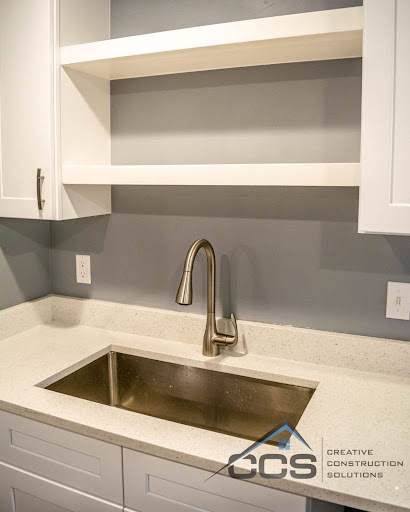
Lighting and ventilation transform a basement kitchenette from merely functional to truly inviting. Proper lighting not only enhances the aesthetics of the space but also ensures safety and functionality, while adequate ventilation is crucial for maintaining a comfortable and healthy environment, especially in a basement setting.
For lighting, the key is to create a layered approach that combines ambient, task, and accent lighting.
Ambient lighting provides the overall illumination of the space. Recessed ceiling lights or flush mounts are great for this purpose, offering a clean, unobtrusive look.
Task lighting is good for food preparation areas. Under-cabinet lighting is a popular choice, as it brightens countertops without casting shadows.
Accent lighting, such as LED strip lights or pendant lights, adds a touch of style and can be used to highlight specific kitchenette features.
In any part of a home, it’s important to keep air circulating to avoid dampness and odors, which are common issues in basement spaces. If your basement kitchenette includes cooking appliances, install a range hood or an exhaust fan to remove cooking fumes and heat.
For general ventilation, consider installing a ceiling fan or a ventilation system that can help circulate fresh air throughout the space. If needed, dehumidifiers can help maintain appropriate moisture levels so your basement kitchenette remains comfortable and mold-free.
As you embark on the exciting journey of adding a kitchenette to your basement, remember that the key to success lies in thoughtful planning and attention to detail. From choosing the right layout and appliances to picking the materials for countertops, each element plays a crucial role in creating a functional and inviting space.
If you're feeling inspired but need help figuring out where to start, Creative Construction Solutions is here for you. Our team of experts specializes in basement renovations, and we're dedicated to bringing your vision to life. We understand the unique challenges and opportunities that come with basement transformations and are equipped to guide you through every step of the process.
Don't hesitate to reach out to us for expert guidance and personalized service. Contact Creative Construction Solutions and fill out our consultation form. Let's work together to create a basement kitchenette that exceeds your expectations and becomes a cherished part of your home.
